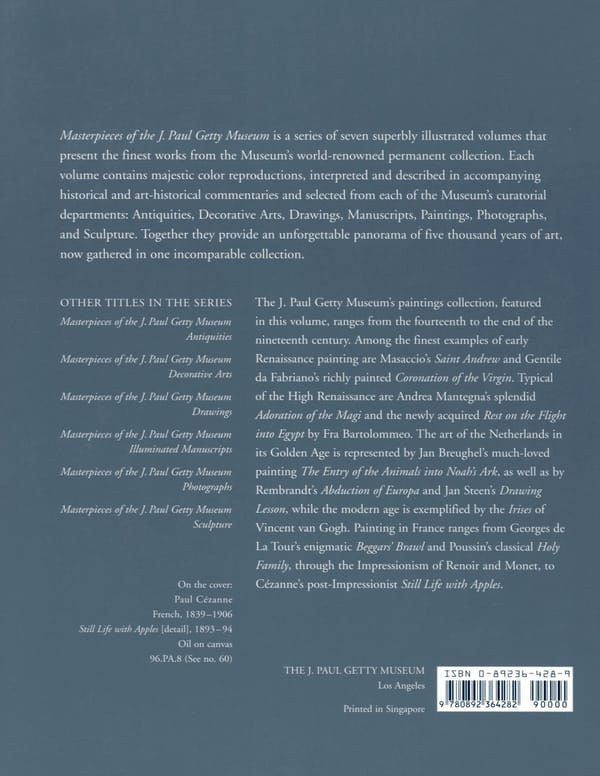Masterpieces of the Getty Museum: Paintings
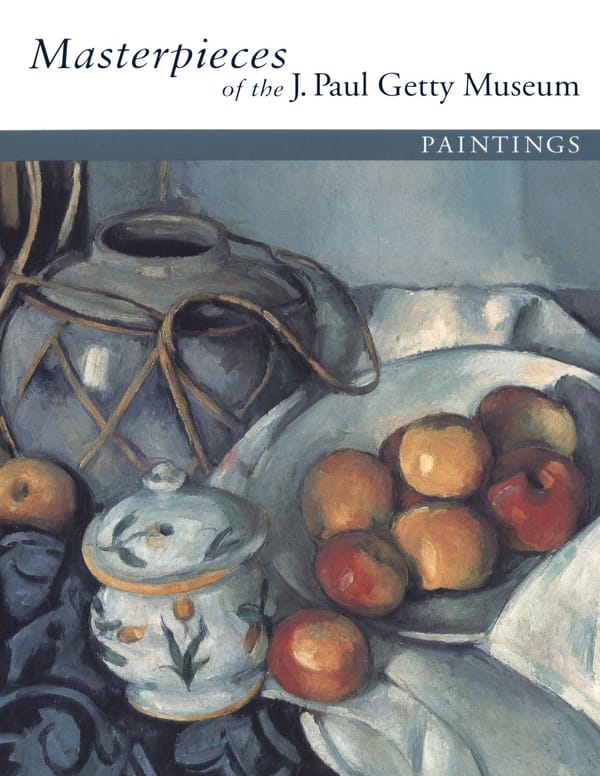
Masterpieces of the J. Paul Getty Museum PAINTINGS
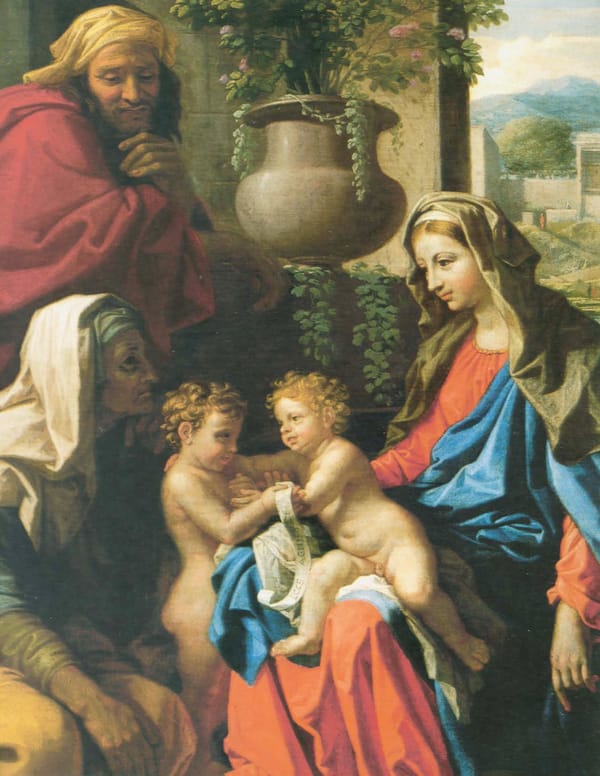
Masterpieces of the J. Paul Getty Museum PAINTINGS Los Angeles THE J. PAUL GETTY MUSEUM
Frontispiece: NICOLAS POUSSIN French, 15941665 The Holy Family [detail] ,1651 Oil on canvas 81.PA.43 (See no. 42) At the J. Paul Getty Museum: Christopher Hudson, Publisher Mark Greenberg, Managing Editor Mollie Holtman, Editor Suzanne Watson Petralli, Production Coordinator Lou Meluso and Jack Ross, Photographers Text prepared by Burton Fredericksen, David Jaffé, Dawson Carr, Denise Allen, Jennifer Helvey, and Perrin Stein Designed and produced by Thames and Hudson and copublished with the J. Paul Getty Museum © 1997 The J. Paul Getty Museum 1200 Getty Center Drive Suite 1000 Los Angeles, California 900491687 Library of Congress Card Number 97070931 ISBN 0892364289 Color reproductions by CLG Fotolito, Verona, Italy Printed and bound in Singapore by C.S. Graphics
CONTENTS DIRECTOR'S FOREWORD 7 ITALIAN SCHOOL 8 DUTCH AND FLEMISH SCHOOLS 42 FRENCH SCHOOL 74 OTHER SCHOOLS 112 INDEX OF ARTISTS 128
This page intentionally left blank
DIRECTOR'S FOREWORD Turning the pages of this book gives us who work at the Getty Museum a particular exhilaration. Our most difficult and expensive task since 1983 has been to build an important collection of European paintings in a time of dwindling supply. This survey of the Museum's finest paintings provides a measure of our progress, for the reader wise to the code of accession numbers will discover how many of the works have been acquired in the past fourteen years. J. Paul Getty had a puzzling attitude toward paintings, buying them with only fitful enthusiasm. Not until after his death, when the Museum received the benefit of his generous legacy, could the paintings collection be greatly strengthened. As Curator of Paintings between 1965 and 1984, Burton Fredericksen brought a new level of professionalism to collecting, exhibiting, and publishing. His work has spanned several eras, beginning at Mr. Getty's modest housemuseum in the 1960s; continuing through the construction in 19681974 of the present building, a recreated Roman villa; and into the current period of diversification by the Getty Trust and of growth for the Museum. He was followed as Curator of Paintings by Myron Laskin, who served from 1984 to 1989, and George Goldner, who held the position from 1989 to 1993. Each added major pictures and put his own stamp on the collection. David Jaffé has been curator since 1994. His energy has reinvigorated the department and his keen judgment has resulted in many important purchases. Roughly half the texts in this book are the work of Burton Fredericksen; other entries were contributed by David Jaffé, Dawson Carr, Denise Allen, Jennifer Helvey, and Perrin Stein. I am very grateful to all the authors. This book appears just as the paintings are being moved to a new museum, part of the Getty Center in the Santa Monica hills of Los Angeles. Hung in handsome galleries and lighted by daylight, the collection is sure to give even greater pleasure to visitors than it has in the past. JOHN WALSH Director DIRECTOR'S FOREWORD 7
1 SIMONE MARTINI A bastion of conservatism, fourteenthcentury Siena was not immediately affected by Italian, circa 12841344 the progressive currents that the Renaissance brought to Florence and parts of northern Saint Luke, circa 1330 Italy. The adherence to a more orthodox, and therefore less experimental, tradition Tempera on panel allowed local artists to maintain and perfect particularly high standards of craftsmanship. 67.5x48.3 cm (26 9/16 x 19 in.) During the first half of the fourteenth century, however, a number of Sienese artists did 82.PB.72 begin to soften the rigidity of the local Byzantineinfluenced style. Simone Martini was perhaps the most accomplished of this group. In his hands the figure became more elegant and graceful, and the longestablished stylizations of his predecessors began to give way to a greater awareness of the human form and its potential for beauty. Simone often worked for patrons in cities such as Avignon in France that were considerably removed from his birthplace. The poems that Petrarch wrote in praise of Simone spread his reputation and that of the Sienese school beyond the borders of Italy. The Museum's panel depicts Saint Luke, who is identified by the inscription S.LVC[A]EVLSTA (Saint Luke the Evangelist). A winged ox, the saint's symbol, holds his ink pot as he writes his Gospel. This painting is in nearly perfect condition and retains its original frame. It was probably the righthand panel of a fivepart portable polyptych, or multipart altarpiece. The remaining four sections (three of which are in the Metropolitan Museum of Art, New York; the fourth is in a private collection in New York) depict the Madonna (the central panel) and three other saints. The panels were probably hinged together with leather straps so that the altarpiece could be folded and carried. Holes in the top of the frame indicate that there may have been attachable pinnacles, perhaps with angels. The fully expanded altar would have been almost seven feet in width. It has recently been suggested that the altarpiece was originally painted for the chapel in Siena's Palazzo Pubblico. Portions of some of the panels were painted by the artist's assistants, but the Getty Museum's panel was executed entirely by Simone. The refinement of design, the extreme elegance of the hand, the slightly elongated figure, and the intensity of the expression are all hallmarks of his work. BF 8 ITALIAN SCHOOL
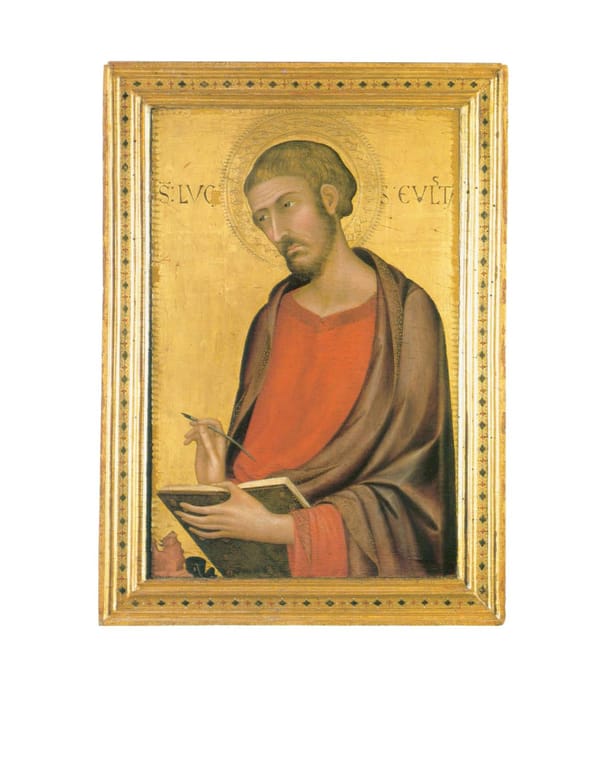
2 BERNARDO DADDI This beautifully preserved triptych was painted in Florence at about the same moment Italian, circa 12801348 that Simone Martini was painting the Saint Luke (no. 1) in nearby Siena. Daddi, The Virgin Mary with Saints however, endows his figures with greater bulk and physicality, modeling them with Thomas Aquinas and Paul, subtle gradations of light and shade that caused contemporaries to marvel at their circa 1330 profound presence. Their natural, human quality epitomized Giotto's recent Tempera and gold on panel revolutionary example and heralded the dawn of the Renaissance in Florence. These Central panel: 120.7 x 55.9 cm (47½ x 22 in.) artists established that the observation of nature would dominate European artistic Left panel: 105.5 x 28 cm inquiry for centuries to come, but certain details, such as the almondshaped eyes, (41½ X 11 in.) the rich, ornamental patterning of the Madonna's bodice, and the exquisite gold Right panel: 105.5 x 27.6 cm (41½ x 10 7/8 in.) ground reveal that Byzantine abstraction was not yet totally abandoned. 93.PB.16 The image of the halflength Madonna flanked by fulllength standing saints became a popular form of devotional imagery. The choice of Saints Thomas Aquinas and Paul most probably reflects some significance to the original owner, perhaps indicating his name. In a trefoil (threepart leaf) above, Jesus Christ gives his blessing. The size of the triptych indicates that it was probably intended for a small chapel, as it is too large for portable use and too small for a church altar. The gilt ground was meant to convey the impression of solid gold to pay homage to the depicted holy figures. This ground also has a spatial function, creating a kind of gold empyrean that removes the figures from the earthly and transports them to the heavenly realm. Nevertheless, Daddi's Virgin is virtually thrust into our space as her hand overlaps the marble parapet, making her humanity all the more accessible. As she reads the Magnificat (Luke 1:46–48), she gestures to something outside the painting, an altar or a tomb positioned below. In this way, Daddi celebrates Mary's role as the most potent intercessor, the serene, compassionate link between our world and the realm of God. DC 10 ITALIAN SCHOOL
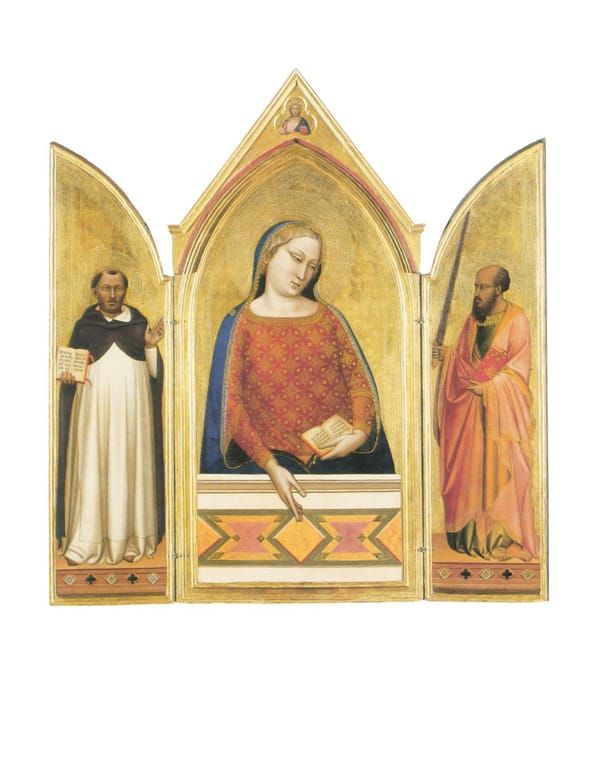
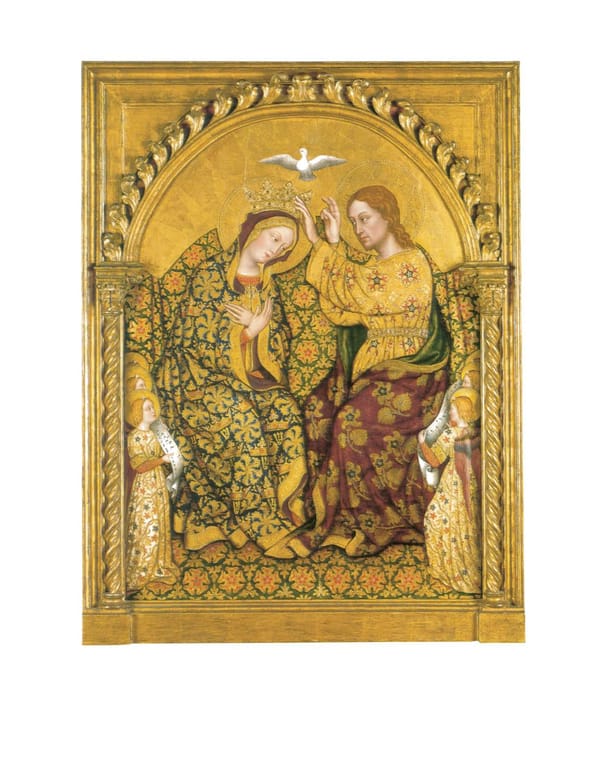
3 GENTILE DA FABRIANO A rare surviving example of a processional standard, The Coronation of the Virgin was Italian, circa 1370-1427 meant to be carried on a pole in religious parades. It is painted in brilliant colors over The Coronation of the Virgin, a layer of gold leaf and once had an image of God the Father in a tympanum, a separate circa 1420 section that was attached above; this has since been lost. The standard was also originally Tempera on panel double sided and was sawed into two sections sometime prior to 1827. The reverse, 87.5 x 64 cm (34½ x 25¼ in.) The Stigmatization of Saint Francis, is now in the Magnani-Rocca collection in Reggio 77.PB.92 Emilia in northern Italy. The choice of subjects and the evidence of existing documents indicate that the standard was painted for the Franciscan monks in Fabriano and kept at the Church of San Francesco. The painting was moved about to different locations over the course of the next four centuries as churches were torn down and replaced, but because of its connection with Gentile, the town's most famous son, it was revered in Fabriano long after such paintings ceased to be made. By the 1830s, however, such relics of the late Middle Ages and Renaissance had become highly coveted, and an English collector was able to purchase The Coronation. Gentile is thought to have painted the standard on a visit to his hometown in the spring of 1420, rather late in his illustrious career. By this time he had acquired fame and prestige throughout Italy as the greatest artist of his generation. Although relatively few of his paintings survive, his works had an enormous influence (in part because of their strong sense of space and form) on his contemporaries. In the Museum's panel, the artist has composed his scene using a number of rich fabrics with large and colorful patterns, a device that did not permit him to develop the spatial aspects of the painting to his usual degree. Christ both blesses and crowns the Virgin, an unusual detail for this time, while to each side the angels sing songs inscribed on scrolls. The total effect is one of luxuriousness and opulence befitting a panel that was once one of the town of Fabriano's most venerated religious treasures. BF ITALIAN SCHOOL 13
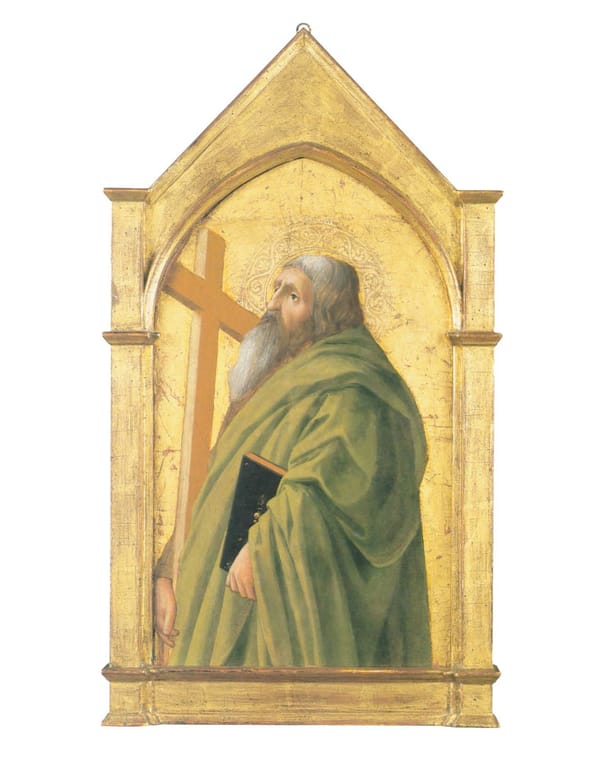
4 MASACCIO Masaccio's brief but unparalleled career was marked by a few major works, including (Tommaso di Giovanni Guidi) an altarpiece painted for the Church of the Carmine in Pisa, a cycle of frescoes for the Italian, 14011428 (?) Brancacci chapel in the Church of the Carmine in Florence, and a fresco depicting the Saint Andrew, 1426 Trinity in the Church of Santa Maria Novella in Florence. All were painted within a Tempera on panel span of about four years, but the only one of these that is clearly documented from the 52.4 x 32.7 cm (20 x 12 in.) time is the altarpiece for Pisa, an epochal work that became famous immediately. It is 79.PB.61 to this altarpiece that the Museum's panel once belonged. Masaccio, a citizen of Florence, began work on the Pisa altarpiece in February 1426, and he must have spent much of his time in Pisa until its completion the day after Christmas. The chapel in which it was to be placed had been constructed the year before at the request of Ser Giuliano di Colino degli Scarsi, a welltodo notary in Pisa. The notary's records of payment show that Masaccio used two assistants, his younger brother Giovanni and Andrea di Giusto, both of whom later became respected artists in their own right. The central part of the altarpiece, now in the National Gallery, London, depicts the Madonna and Child with angels singing and playing instruments. At the sides were panels of Saints Peter, John the Baptist, Julian, and Nicholas (now presumed lost). In the predella, the platform or base under the altarpiece, were stories from the lives of these saints and The Adoration of the Magi (all of which are now in the Staatliche Museen Preussischer Kulturbesitz, Berlin). Above the Madonna was The Crucifixion (most probably the painting now in the Museo e Gallerie Nazionali di Capodimonte, Naples), and on either side in the upper register were many other saints. The Getty panel of Saint Andrew is presumed to have been one of these. The entire altarpiece was about fifteen feet tall, a large and imposing construction. The value of Masaccio's work lies in its innovative rendering of the figure and its very original understanding of form and volume, both of which are seen in the monumentality and solidity of the figure of Saint Andrew. The artist is given credit for having begun an entirely new phase in the history of painting and for being the first since classical times to project a rationally ordered illusion of space onto a twodimensional surface. As much as any other painting, this altarpiece marks the beginning of the Renaissance in fifteenthcentury Tuscany. BF ITALIAN SCHOOL 15
5 ERCOLE DE' ROBERTI During his fouryear spiritual sojourn in the Egyptian desert, Saint Jerome (342—420) Italian, circa 1450/56–1496 purified his spirit through physical suffering. Sheltered by vaulted ruins reminiscent Saint Jerome in the Wilderness, of a church, the emaciated saint contemplates a crucifix as he clasps a rock with which circa 1470 to beat his breast. The intensity of Saint Jerome's gaze upon the crucifix suggests his Tempera on panel religious and intellectual fervor. In the nook at the apex of the structure are Jerome's 34 x22 cm (13 x 8 in.) most prominent attributes: a book, alluding to his translation of the Bible into Latin, 96.PB.14 and a cardinal's hat, referring to his service to Pope Damascus I (r. 366384) in Rome. The small lion, a species apparently known to the artist only from a book illustration, refers to a popular fable in which Jerome pulls a thorn from the paw of a lion, winning its devoted friendship. Ercole de' Roberti worked principally in Ferrara, one of the most brilliant citystates of the Renaissance in northern Italy, where he was instrumental in forging the elegant classicizing style for which the city is famous. Ercole made his distinctive contribution with exquisitely precise works of haunting, emotional introspection such as the Saint Jerome. The elongated forms, taut, linear rhythms, subtle colors, and meticulous, gold flecked details exemplify the stylistic sophistication prized by Ercole's patrons at the court of Ferrara. The quiet, elegant classicism of his work, derived in part from his study of Mantegna, is epitomized in the figure's beautifully expressive, sinuous limbs and hands. The artist's fascination with layering to build forms manifests itself in the vertical wood pilings beneath the saint and the delicately stratified rocks. This small, jewellike devotional work demands a focused concentration from the viewer that echoes Jerome's efforts to come closer to God. JH 16 ITALIAN SCHOOL
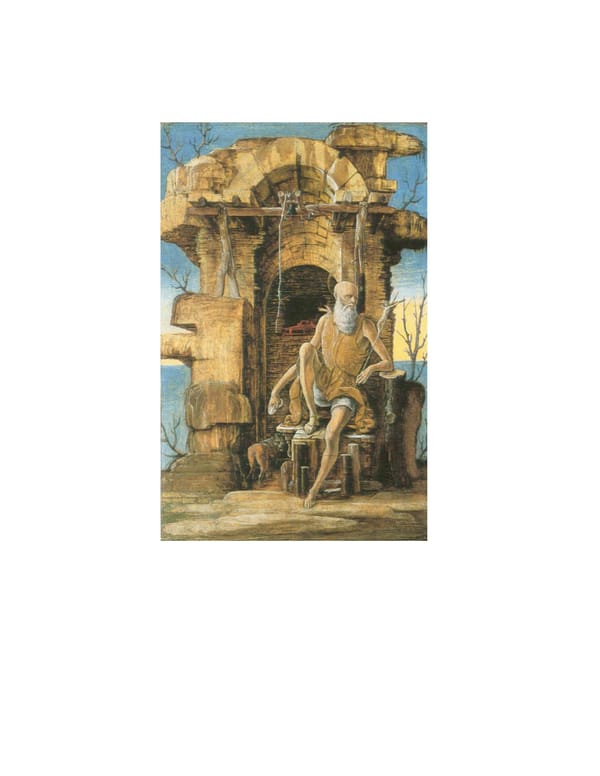
6 VITTORE CARPACCIO Carpaccio was one of the first Renaissance painters to employ scenes of everyday life in Italian, 1460/65-1525/26 his work. This striking view of his native Venice shows cormorant hunters on a lagoon. Hunting on the Lagoon, Note that the hunting party does not use arrows but rather shoots pellets of dried clay, circa 1490-95 apparently to stun the birds without damaging their flesh or plumage. In an early Oil on panel instance of arrested action in a picture, one such pellet, just fired from the boat at right, 75.4 x 63.8 cm (29¾ x 25 in.) can be seen in midair, about to clout the cormorant in the foreground. 79.PB.72 This panel is the top part of a composition that was originally much longer, as the truncated lily in the lower left corner suggests. It served as the background for a scene of two women sitting on a balcony overlooking the lagoon, now in the Museo Correr in Venice. That painting has a vase with a stem sitting on a balustrade that matches up with the blossom in the Getty painting. Recent examination of both panels confirmed that they were once one; the wood grain is identical, and much like a fingerprint, wood grain is unique. Sadly, they were probably sawed apart for commercial reasons sometime before the bottom part entered the Museo Correr in the nineteenth century. The back of the Correr's panel was removed, presumably at the time it was separated from the top, but the reverse of the Museum's painting preserves an extraordinary image. The illusionistic letter rack, with letters seemingly projecting into the viewer's space, is the earliest known trompe-l'oeil (fool the eye) painting in Italian art. The back also has grooves cut for hinges and a latch, indicating that the two-sided panel probably functioned as a decorative window shutter or a door to a cabinet. This suggests that there may have been a matching shutter or door unknown today. If the painting served as a shutter, when closed the panel would have made the spectator think the window was open to this vista of the lagoon, extending the remarkable illusionism even further. DC 18 ITALIAN SCHOOL
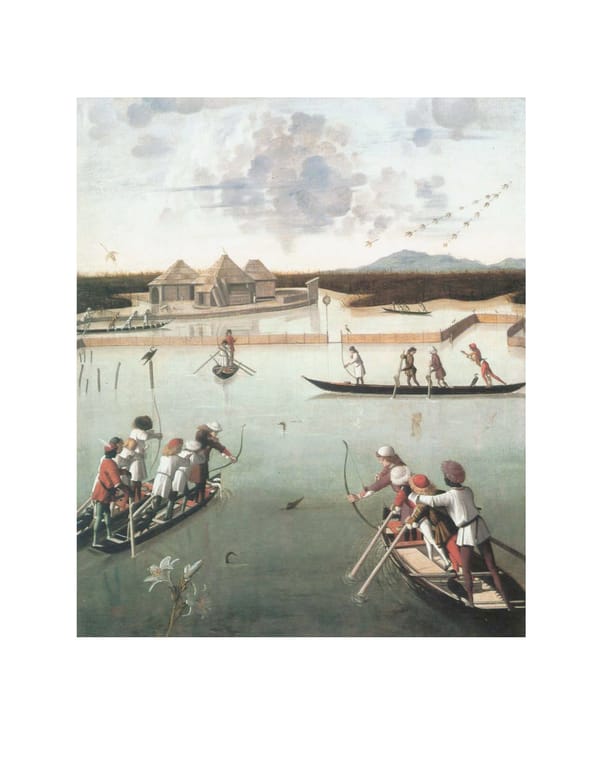
7 ANDREA MANTEGNA The Renaissance was characterized by an intense reawakening of interest in classical Italian, circa 14311506 art and civilization. During the fifteenth century, some of the most overt emulation The Adoration of the Magi, of "classical" style occurred in northern Italy, especially in Padua and Mantua. This circa 14951505 was primarily due to the influence of Andrea Mantegna, who worked in both cities Distemper on linen and spent much of his career in the court of the Gonzaga of Mantua. 54.6 x 69.2 cm (21½ x 27 in.) Although Mantegna probably had no examples of classical painting for study, 85.PA.417 he did have access to some sculpture and to recently excavated fragments of Roman figures and reliefs. In his religious pictures, as well as his works with classical or mythological themes, the emphasis on sculptural models is apparent. His style is characterized by sharp definition of figures and objects, combined with a clear articulation of space. Some of his pictures are executed in grisaille, or tones of gray, as if he were imitating reliefs, and they give the impression of having been carefully carved in great detail. The Museum's painting was most probably made in Mantua, very possibly for Francesco II Gonzaga. It has a completely neutral background with no attempt to indicate a setting. Kneeling before the Holy Family are the three kings: the bald Caspar, Melchior, and Balthasar the Moor. The hats worn by Melchior and Balthasar are reasonably accurate representations of oriental or Levantine headgear. Caspar presents a blueandwhite bowl of very fine Chinese porcelain (one of the earliest depictions of oriental porcelain in Western art). Melchior holds a censer, which has been identified as Turkish tombac ware, and Balthasar offers a beautiful agate vase. Objects of this sort were not commonly found in Italy, although some of the costume accessories might have been seen in Venice, which maintained an active trade with the East. They may have been gifts from foreign heads of state that formed part of the Gonzaga collections. The Museum's Adoration is one of the few fifteenthcentury Italian paintings executed on linen instead of wood. Such pictures were not originally varnished because they were painted in distemper rather than oil. Varnish applied at a later time has darkened the linen, but the beauty of the figures and the richness of the detail have hardly been affected. BF 20 ITALIAN SCHOOL
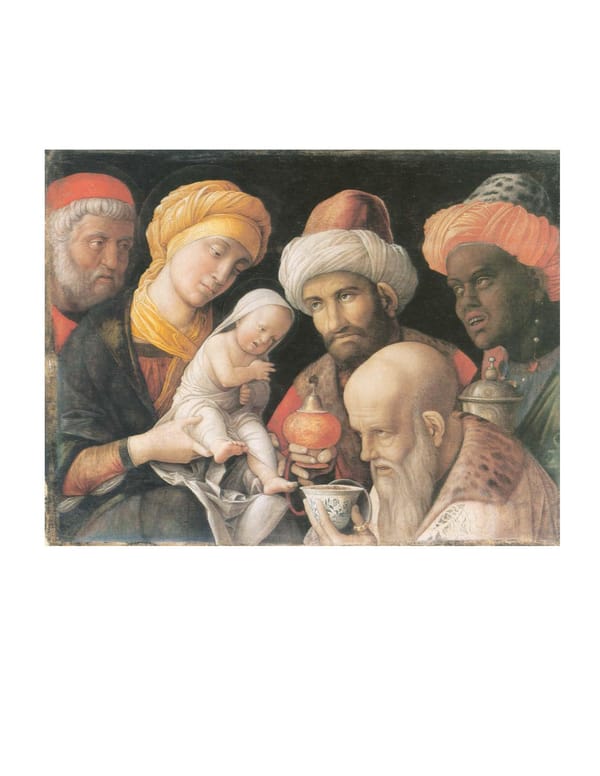
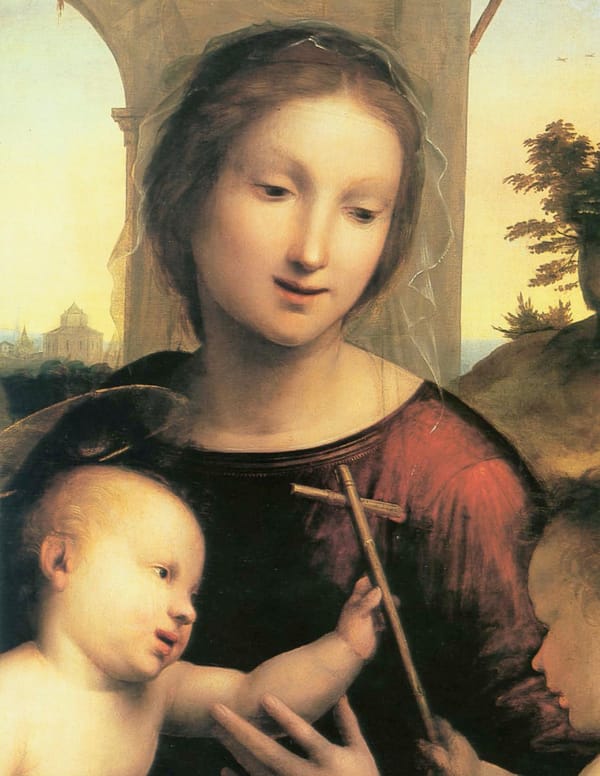
8 FRA BARTOLOMMEO (Baccio della Porta) Italian, 14721517 The Rest on the Flight into Egypt with Saint John the Baptist, circa 1509 Oil on panel 129.5 x 106.6 cm (51 x 42 in.) 96.PB.15 Fra Bartolommeo painted this work in 1509, immediately after his return to Florence from Venice. The calm grandeur and inventive subject of The Rest on the Flight illustrate the artist's fresh response to the monumental Florentine High Renaissance style, initiated by Leonardo, Michelangelo, and Raphael. In this beautifully orchestrated dialogue of gesture and glance, the Holy Family, having escaped Bethlehem and King Herod's massacre of the innocents, take their ease beneath a date palm tree. Mary and Joseph look on as the infant John the Baptist greets the Christ Child, who grasps John's reed cross despite his mother's restraining hand. The Baptist's presence is a poignant reminder that the ultimate purpose of the Child's escape is his sacrifice on the cross. Fra Bartolommeo reinforces the pathos by including the pomegranate, a fruit that prefigures Christ's death, and the sheltering palm, whose fronds will pave the Savior's final entry into Jerusalem. The ruined arch alludes to the downfall of the pagan order and the rise of Christ's church, personified by Mary. Fra Bartolommeo captures the Florentine ideal of beauty in the Madonna's gracefully turning pose and in the even curves of her softly modeled face and neck. The painter's fascination with nature is suggested by his masterful handling of the diffuse golden light emanating from the mistshrouded city of Bethlehem, the crisply detailed palm tree, and in the freely painted feathers of the rustling bird on the arch. DJ ITALIAN SCHOOL 23
9 GIULIO ROMANO (Giulio Pippi) Italian, before 14991546 The Holy Family, circa 152023 Oil (possibly mixed with tempera) on panel 77.8 x 61.9 cm (30 x 24 in.) 95.PB.64 Giulio Romano was Raphael's most important protege. Upon Raphael's death in 1520, Giulio assumed leadership of his master's Roman shop, a position he maintained until 1524 when he left his native city to become court painter to the Duke of Mantua. Because the artists collaborated so closely, the distinction between Raphael's and Giulio's hands remains hotly debated. However, this Holy Family is replete with mannerisms that can be securely connected with Giulio's later independent works, particularly the metallic palette, heavy physiognomies, and a preoccupation with surface ornamentation. In this panel Giulio elaborates upon the familiar subject of the Holy Family. The arrival of the woman with the doves of purification identifies this scene as the moment when the infant Christ and Saint John the Baptist first meet. Both Joseph and Mary look protectively down on the two precocious readers, forming a cleverly orchestrated interlocking group. Giulio typically includes lively details, such as the dog dashing out of a doorway at the left and the beautifully realized all'antica landscape at the right. The panel probably dates from the period between Raphael's last work, The Transfiguration (1520), and Giulio's Martyrdom of Saint Stephen (1523). It shows Giulio working as Raphael's heir, continuing the same stylistic idiom and yet allowing his own design preferences to become more apparent. DJ 24 ITALIAN SCHOOL
10 CORREGGIO (Antonio Allegri) Italian, circa 1489/94-1534 Head of Christ, circa 1525—30 Oil on panel 1 28.6 x 23 cm (11¼ x 9 /16 in.) 94.PB.74 Antonio Allegri, known as Correggio after the town of his birth, was the leading High Renaissance artist in the region of Emilia in north-central Italy. The Head of Christ illustrates Correggio's invention of a new type of devotional imagery where the figures seem to be caught in vibrant, realistic moments. The subject derives from the legend of Saint Veronica. When Christ fell on the way to the Crucifixion he was comforted by Veronica, who wiped his face with her veil, miraculously impressing his image upon it. Instead of the traditional iconic composition, which derived from the relic of the Savior's face imprinted on the veil, Correggio portrays a hauntingly naturalistic Christ, who turns toward the viewer and parts his lips as if to speak. Veronica's veil is the folded, white cloth background that wraps around Christ's shoulder and ends in soft white fringes at the lower right. The painting's profound devotional impact depends upon Correggio's bold invention: Christ is shown wrapped within the veil at the instant before the miracle. The artist has made it appear that the living face of Christ turns to confront the viewer. Correggio's reassessment of a traditional image intended for contemplation and private prayer may be related to the renewed sense of piety that followed the return of Veronica's veil, along with the other principal relics of Christendom, to the Basilica of Saint Peter's after their theft during the sack of Rome in 1527. Numerous copies of the Head of Christ attest to the success of the novel composition and to the high regard in which this artist, long considered second in stature only to Raphael, was held. DA ITALIAN SCHOOL 25
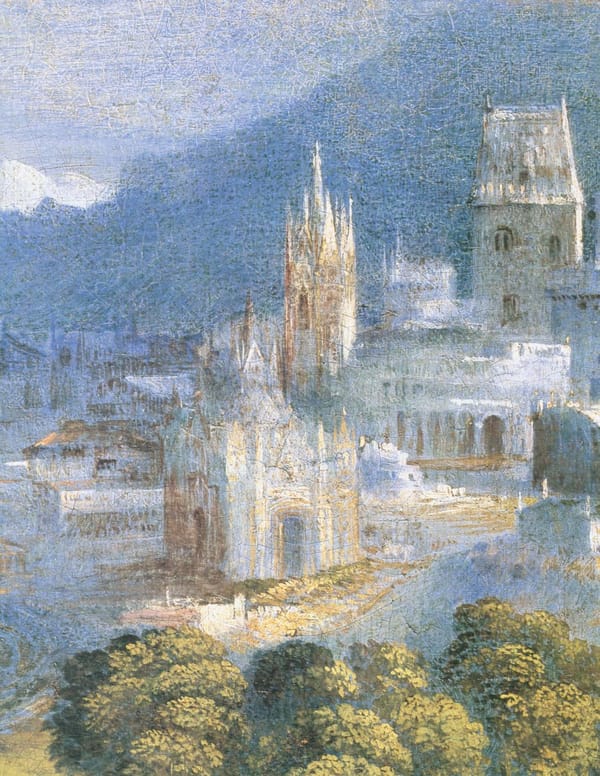
11 DOSSO DOSSI (Giovanni de' Luteri) Italian, circa 1490-1542 Mythological Scene, circa 1524 Oil on canvas 163.8 x 145.4 cm (64½ x 57¼ in.) 83.PA.15 During the early sixteenth century, the ducal court at Ferrara assembled and employed some of the most original and brilliant painters, writers, and musicians of the time. Most of this activity was initiated by Duke Alfonso I d'Este (1505-1534), who brought together painters such as Raphael from Rome and Giovanni Bellini and Titian from Venice. The collection of pictures that the duke assembled, however, focused primarily on the work of two local artists, the brothers Dosso and Battista Dossi. The brilliant color and poetic mystery of the Venetian style pervade the brothers' works, but they also demonstrate a fascination with classical motifs, elaborate compositions, and figural poses that seem to derive from Rome. The Museum's canvas, one of the largest surviving works by Dosso, exemplifies all of these influences. Many of Dosso's best pictures still defy precise explanation because of their complex themes and eccentric or obscure allegorical programs. This painting is generally assumed to be mythological because the Greek god Pan appears on the right. It has been suggested that the wonderful nude lying in the foreground could be the nymph Echo, whom Pan loved; the old woman may be Terra, Echo's protector. Dosso did not intend the woman in the flowing red cape on the left to be seen. After completing this figure, he painted over her with a landscape; this was scraped off at a later date. At some point the painting was also cut down by about six inches on the left side, so that the figures originally dominated the composition to a lesser extent than they do now. In spite of the changes that prevent us from seeing the painting exactly as the artist intended, it can be described as one of the most sensual and ambitious of Dosso's works. The beautifully detailed flowers in the foreground, the almost flamboyant lemon tree, and the fantastic landscape on the left display an exuberant individuality unmatched by any of the artist's illustrious contemporaries. BF ITALIAN SCHOOL 27
12 DOSSO DOSSI This recently discovered painting was executed by Dosso at least a decade after the (Giovanni de' Luteri) Mythological Scene illustrated on the preceding page. While the luminous, poetic Italian, circa 14901542 coloring and atmosphere of the earlier work reflect Dosso's study of contemporary Allegory of Fortune, circa 1530 Venetian paintings, the Allegory of Fortune illustrates how his work developed toward Oil on canvas a more Roman style dominated by the figure. In fact, the heroically proportioned and 178 x 216.5 cm (70½ x 85½ in.) posed figures of the Allegory are closely based on examples in Michelangelo's Sistine 89.PA.32 Chapel ceiling. The woman represents Fortune, or Lady Luck, the indifferent force that determines fate. She is nude and holds a cornucopia, flaunting the bounty that she could bring. Her solitary shoe indicates that she not only brings fortune but also misfortune. While these characteristics conform to traditional depictions of Fortune, Dosso handles her other attributes creatively. Fortune was often shown with a sail to indicate that she is as inconstant as the wind, but Dosso employs an artful flourish of billowing drapery. Likewise, Fortune was often depicted balancing on a terrestrial or celestial sphere to represent the extent of her influence, but with characteristic wit, Dosso has her sitting precariously on a bubble, a symbol of transience, to stress that her favors are often fleeting. The man can be understood as a personification of Chance, in the sense of luck (sorte) rather than opportunity {occasio). He looks longingly toward Fortune as he is about to deposit paper lots or lottery tickets in a golden urn. The tickets are nor a traditional attribute but rather a timely reference to the civic lotteries that had recently become popular in Italy. The paper lottery tickets had yet another association for the society in which Dosso worked. They would have been recognized as an emblem of Isabella d'Este, marchioness of Mantua. One of her learned advisors stated that she chose this image to denote her personal experience of fluctuating fortune. It is possible that Dosso created this painting for Isabella and that its meaning is tied to the vicissitudes of her life at the court of Mantua. Whether or not this is ever established with certainty, the haunting mood of the painting invites the presentday viewer to reflect on how life still seems at the whim of Lady Luck. DC 28 ITALIAN SCHOOL
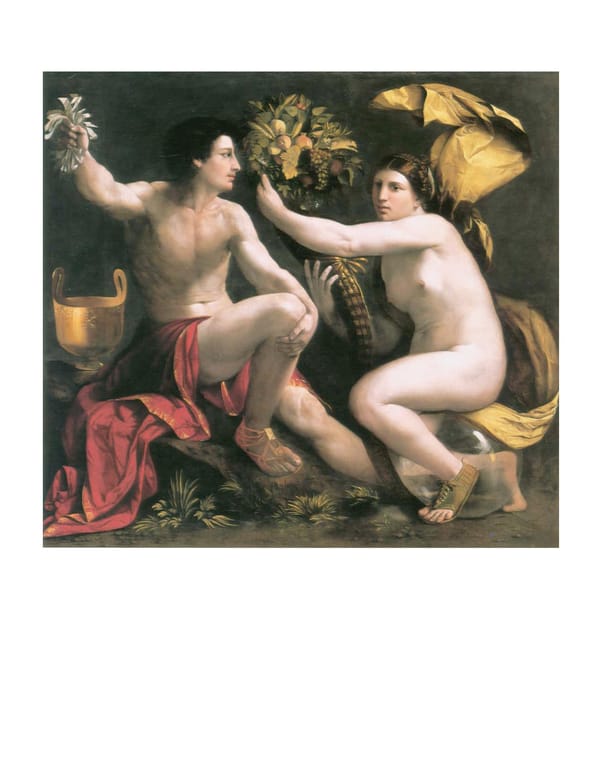
13 SEBASTIANO DEL PIOMBO (Sebastiano Luciani) Italian, circa 14851547 Pope Clement VII, circa 1531 Oil on slate 105.5 x 87.5 cm (41½ x 34½ in.) 92.PC.25 This portrait depicts Giulio de' Medici (14781534), who reigned as Pope Clement VII from 1523. Clement is principally remembered as one of the greatest patrons of the Renaissance. His art commissions include Raphael's Transfiguration (Rome, Pinacoteca Vaticana), Michelangelo's Medici Chapel and Laurentian Library (Florence, San Lorenzo), as well as the Last Judgment for the Sistine Chapel (Rome, Vatican). Clement was also Sebastiano's greatest benefactor, from the commission for The Raising of Lazarus (London, National Gallery) in 1517 to the bestowal of the high office of Keeper of the Papal Seals in 1531. Sebastiano's portrait style has a distinctive, monumental grandeur particularly suited to state portraits like this one. The pope is depicted in threequarter length, seated in an armchair that is canted diagonally to the picture plane. The first independent papal portrait to adopt this format was Raphael's Portrait of Julius II (London, National Gallery) of 151112. Sebastiano's several portraits of Clement VII are the next images to use the compositional arrangement, establishing it as the standard for state portraits of the pontiff. Thereafter, the formula has been followed almost invariably by the popes painters and photographers to the present day. This portrait, painted on slate, is probably the one Sebastiano mentioned in a letter to Michelangelo dated July 22, 1531. Aspiring to eternalize his works, Sebastiano began to experiment with painting on stone about 1530. Slate had not often been used as a support for painting, but Sebastiano came to favor it for especially important commissions. The pope seems to have shared his concern with longevity as he specified the stone support for his portrait. They both knew that wood and canvas would rot, and that slate is extremely durable, as long as it is not dropped. DC 30 ITALIAN SCHOOL
14 PONTORMO (Jacopo Carucci) Italian, 1494-1557 Portrait of a Halberdier (Francesco Guardi?), 1528-30 Oil on panel transferred to canvas 92 x 72 cm (36¼ x 28 in.) 89.PA.49 Jacopo Pontormo, court painter to Duke Cosimo de' Medici and one of the founders of the so-called Mannerist style in Florence, excelled as a portraitist. The Halberdier is his greatest achievement. Much has been written about the identification of the sitter. In 1568, the chronicler of artists' lives, Giorgio Vasari, noted that during the 1528-30 siege of Florence Pontormo painted a "most beautiful work," a portrait of Francesco Guardi as a soldier. We know nothing of Francesco's appearance, yet his birthdate of 1514 would make him about the age of Pontormo's teenage sitter. The name of the rival claimant, Cosimo de' Medici, is based solely on a 1612 Florentine inventory. Pontormo shows his halberdier before a bastion as if defending the city. The physical confidence conveyed by his swaggering pose, slung sword, and loose grip on the halberd (spear) suggest a control that is belied by his anxious expression. This ambivalent message is reinforced by his garb. His casually worn, fashionable red cap is decorated by a hat badge showing the heroic deed of Hercules overcoming Antaeus. Our unbloodied fighter stares into the unknown, his expression suggesting he has just become aware of the myth of the immortality of youth. According to Vasari, this "most beautiful" portrait of Francesco Guardi had a cover with the legend of Pygmalion and Galatea (Florence, Palazzo Vecchio) painted by Pontormo's talented pupil Bronzino. The extraordinary quality of the Getty portrait certainly merits Vasari's epithet. Pontormo's brilliant handling of paint and edgy repetition of forms create a vibrant personality, an achievement as impressive as Pygmalion giving life to stone. DJ ITALIAN SCHOOL 31
15 TITIAN The Venetian painter Titian's dominance of the international art world of his time arose (Tiziano Vecellio) from his ability as a state portrait maker and as an illustrator of classical mythology. Italian, circa 14801576 Venus and Adonis was one of his most famous mythological compositions. The story Venus and Adonis, from Ovid's Metamorphoses tells how the goddess of love failed to persuade the hunter circa 1560s to stay with her and he instead rushed off to his death. The slumbering Cupid with Oil on canvas ineffective love arrows still in the quiver and the mateless partridge beside the upturned 160 x 196.5 cm (63 x 77 in.) 92.PA.42 wine jug all indicate that Venus's last impassioned glance will fail to restrain the toobold hunter. Designed originally for one of his closest and most supportive patrons, Philip II, King of Spain, the present painting is one of many more mature free variants painted for some asyet unidentified admirer. Titian wrote to Philip that his Adonis was to show a back view of Venus as foil to his earlier frontal nude composition. Faced with the sensuously compressed buttocks, it is easy to simply read such paintings as exploiting female nudity, as indeed did several of his contemporaries. In fact Titian's challenge was to render the ancient mythology in a believable and enticing way. As had Raphael and Correggio before him, Titian drew inspiration from an ancient basrelief. Such a quotation of a Roman invention is at the heart of our concept of the Renaissance as the rebirth of ancient art, and for Titian it was a way of authenticating his composition. But he has translated the image in a series of centrifugal forces, showing Adonis unraveling himself from Venus's embrace while one of his hunting dogs turns back with glistening eyes to contemplate the pleasures relinquished for those of the chase. The canvas is replete with examples of Titian's house style of painting, visible in the drapery fold highlights that enliven the cloth in sharp zigzags, almost as if charged with static electricity; the almost imperceptible modeling of flesh; the flashy curls of hair; and the staging of Adonis's cape, which shimmers against the evocative mountains. Venetian artists were famous for their preoccupation with the painterly rendering of the effects of light on surfaces, designing in color and not just line, and Titian was a genius at using these effects to create evocative moods. Titian's task was to make a fantasy world both believable and desirable, and he has succeeded in bringing its superhuman protagonists alive and convincing us of their tragic love story. The central figures were evidently traced and reused to generate further variants of this composition in the Palazzo Barberini and the National Gallery, London. DJ 32 ITALIAN SCHOOL
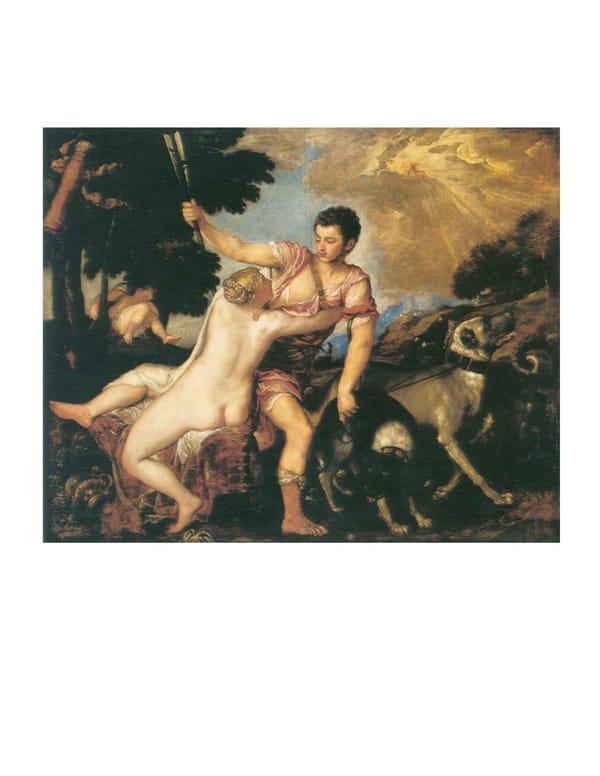
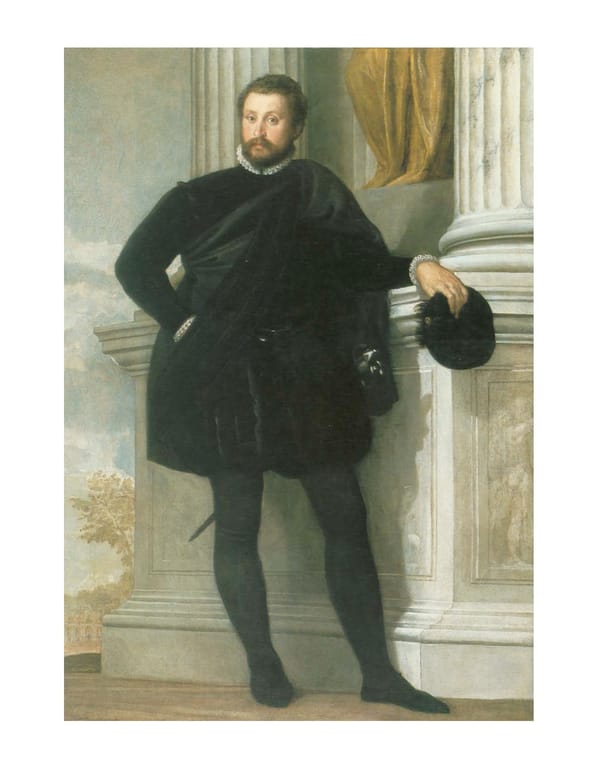
16 VERONESE The subject of this imposing portrait leans on a large socle, or base, supporting fluted (Paolo Caliari) columns; between these columns is a niche containing a marble sculpture of a draped Italian, 1528-1588 figure, of which only the lower portion can be seen. Carved reliefs adorn the sides of Portrait of a Man, the socle, whose exact subjects are not discernible. The man stands on a pavement of 1576-78 inlaid stone, and in the distance to the left, the distinctive features of the Venetian Oil on canvas Basilica of San Marco can be seen. The church is incongruously surrounded by trees as 192.2 x 134 cm (75 x 52¾ in.) 71.PA.17 if it were in a forest instead of its actual urban setting. All of these details seem intended to provide clues to the subject's profession or identity. Perhaps he had some connection with San Marco, although this would not explain the basilica being represented in this unusual setting. He may have been an architect or even a sculptor, but nothing about his clothing or his appearance confirms this. The sword at his side, in fact, suggests that he may have been a nobleman. Traditionally, the subject has been described as the artist himself, but this cannot be confirmed. There are some indications that Veronese may have been bearded, and he seems to have had a high forehead, but his exact appearance is unknown. Moreover, it seems unlikely that he would have painted himself standing in formal clothing against some columns with a sword at his waist, and he had no special connection with the Basilica of San Marco. Perhaps because he had so many commissions to paint large decorative cycles in Venice, Veronese generally avoided less lucrative categories, such as portraits, for which his contemporaries Tintoretto and Titian became better known. In spite of the fact that he did not depend upon his reputation as a portraitist, he was a very skillful one, and the size and beauty of the present example—one of the most striking of the few he undertook—indicate that it must have been a particularly important commission for him. It is executed with a painterly verve and freedom of execution that characterize all of the artist's work. BF ITALIAN SCHOOL 35
17 DOMENICHINO (Domenico Zampieri) Italian, 15811641 The Way to Calvary, circa 1610 Oil on copper 53.7 x 68.3 cm (21 x 26 in.) 83.PC.373 Domenichino, a prominent member of the artistic movement founded by the Carracci family, journeyed to Rome in 1602. He worked closely with Annibale Carracci and over the next four decades remained one of his most loyal adherents. Domenichino's career was marked by a series of important fresco projects, but he also painted a number of religious pictures for individual patrons. During his first decade in Rome, he painted a few of these on copper, a support that was popular for small compositions requiring a high degree of finish. The Museum's copper is one of the masterpieces of this early period. It was probably executed about 1610 and is particularly indicative of the care the artist devoted to his work. Domenichino emphasized the careful planning of composition and individual figures, and his execution was exceptionally painstaking. Along with the Carracci, he stood in opposition to the "realist" movement led by Caravaggio and his followers, maintaining instead that nature must be ordered and improved upon. This stance was a rational one, and typically, The Way to Calvary does not emphasize the Savior's suffering, in spite of the brutality of the subject. Domenichino imparted a sense of strength to his figures but eschewed dramatic exaggeration of any kind. The compression of the figures at the sides of this composition may be deliberate, or it may be in part the result of the copper panel having been trimmed at some time after it was painted. BF 36 ITALIAN SCHOOL
18 PIER FRANCESCO MOLA Italian, 16121666 The Vision of Saint Bruno, circa 1660 Oil on canvas 194 x 137 cm (76 x 53 in.) 89.PA.4 Saint Bruno was the founder of the Carthusian order, a monastic community established on the principle that union with God was furthered by continual, solitary meditation. Thus, Carthusians live most of their lives isolated from their brothers, coming together as a community only once a week. Mola's work illustrates the basic principle of Carthusian life by showing their founder alone, turning from his devotions to witness a vision of heaven breaking through the clouds. He reaches out longingly, not frightened, but lost in a sweet, mystical ecstasy. Like many Roman artists of his time, Mola found inspiration in the landscapes created by Venetian painters in the preceding century. One aspect of this is revealed in the rich panorama of browns and ochers, set off by an ultramarine sky and clouds shot through with warm sunlight. Also reflecting Venetian usage, the landscape forms beautifully mimic the figure in a complex counterpoint that echoes his rapture. DC ITALIAN SCHOOL 37
19 BERNARDO BELLOTTO Bellotto's precocious talent was fostered in the studio of his uncle, Canaletto. By the Italian, 1721-1780 mid-1730s the teenager was collaborating with Canaletto on the idealized views of View of the Grand Canal: Venice that had won the older artist fame. One of Bellotto's earliest masterpieces, Santa Maria della Salute and the View of the Grand Canal demonstrates the sweeping monumentality, luminous the Dogana from Campo Santa Maria Zobenigo, circa 1740 contrasts, and the alternatively brushy and liquid handling of paint characteristic of Bellotto's mature work. Richly observed in anecdote as well as physical detail, this Oil on canvas 135.5 x 232.5 cm (53¼ x 91¼ in.) urban view is enlivened by its human element, capturing simultaneously the aging 91.PA.73 grandeur of the city and the momentary quality of everyday life wirhin it. Bellotto's view of the Grand Canal presents a cross-section of Venetian society going about their business on a sunny morning. In the left foreground, the facade of the Palazzo Pisani-Gritti presents an elegant backdrop to the mundane activities of the campo bank. The exuberant Baroque design of Baldassare Longhena's Church of Santa Maria della Salute dominates the opposite bank of the canal. To the right, the sun-bathed facade of the Abbey of San Gregorio rises above a shadowy row of houses. On the far side of the Salute stand the Seminario Patriarcale and the Dogana. The mouth of the canal opens onto a distant vista with the Riva degli Schiavoni visible beyond the bustling commerce of the bacino di San Marco. Over the dogana wall can be seen the pale campanile and dome of San Giorgio Maggiore. The View of the Grand Canal is the primary version of a composition repeated in at least fourteen versions by Canaletto's studio. Its attribution to Bellotto is supported by a pen-and-ink drawing by him in the Hessisches Landesmuseum, Darmstadt, that follows the Getty composition closely. The Cleveland Museum of Art's View of the Piazza San Marco Looking Southwest, long considered the pendant of the Getty Grand Canal, has recently been reattributed to Bellotto. DJ 38 ITALIAN SCHOOL
20 GIOVANNI BATTISTA Executed on six large sheets of watercolor paper, this sweeping view of the western LUSIERI Neapolitan coastline is Lusieri's largest and boldest work. While the clientele for his Italian, circa 17551821 topographical paintings were primarily English aristocrats on the Grand Tour, this A View of the Bay of Naples, extraordinary image was not created for the tourist market. It was made from a 1791 window in the Palazzo Sessa, the Neapolitan residence of Sir William Hamilton, Pen and ink, gouache, British Minister Plenipotentiary from 1764 to 1799. On July 5, 1791, Lusieri wrote and warercolor on paper 102x272 cm (40½ x 107 in.) to Hamilton, then on leave in London, that he had supervised the loading of the "large Along the lower center edge, drawing" onto a ship. It would seem likely that it was this work, perhaps commissioned signed and dated G. B. Lusier 1791 by Hamilton so that when he returned to his often gloomy native land, he could still 85.GC.281 enjoy the sunny vista from his house in Naples and share it with his friends. Detail overleaf While Naples has become much more densely populated in the two centuries since Lusieri made this view, much is still recognizable owing to his remarkable accuracy and clarity. Contemporaries commented on the then unusual practice of drawing and coloring his scenes on the spot rather than in his studio. Lusieri's detailed observation and almost fanatical precision suggest that he used some sort of mechanical aid, such as a camera obscura, whose arrangement of mirrors and lenses enables the tracing of outlines. Whether he did or not, it is clear that he firmly resisted the trend toward the romantic landscape, always seeking to imitate nature faithfully. Unfortunately, Lusieri's painting can be exhibited only occasionally, and then under very low light. The watercolor medium is one of the most fugitive, and every exposure to light means some fading will occur, even if it is not immediately perceptible. Because pigments fade at varying rates, it is remarkable that Lusieri's renowned balance of color is so beautifully preserved in this work. By showing it only periodically, we hope to preserve this magnificent record of the appearance of the Bay of Naples in 1791. DC ITALIAN SCHOOL 39
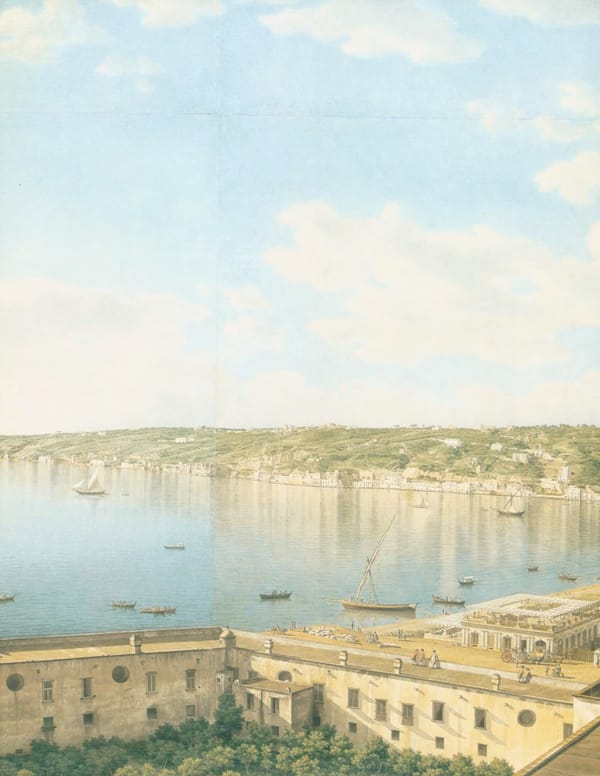
21 DIERIC BOUTS The Annunciation belongs to a set of five paintings that originally constituted a Flemish, circa 14151475 polyptych—an altarpiece that evidently consisted of an upright central section The Annunciation, flanked on each side by two pictures, one above the other. The other scenes in this circa 145055 series have been identified as The Adoration of the Magi (private collection), The Distemper on linen Entombment (London, National Gallery), The Resurrection (Pasadena, Norton Simon 90 x 74.5 cm (35 7/16 x 29 in.) Museum), and probably The Crucifixion in the center (perhaps the painting now in 85.PA.24 the Musees Royaux d'Art et d'Histoire, Brussels). Because the Getty painting depicts the earliest scene in the life of Christ, it was probably placed at the top lefthand corner of the altarpiece. Dieric Bouts was active in Louvain (in presentday Belgium) during all of his mature life. He was the most distinguished of the artists who followed in the footsteps of Jan van Eyck (active 1422died 1441) and Rogier van der Weyden (1399/1400 1464), although much less is known about his life and relatively few of his paintings survive. His style was generally more austere than that of his contemporaries, and his work consistently projects a sense of restraint. It is also typified by great precision. In The Annunciation, the artist has provided a typically convincing sense of space and has gone beyond his predecessors in allowing us to feel the character of Mary's private chamber. It is a relatively colorless sanctuary, much like the cells inhabited by the monks and nuns who normally commissioned and lived with such altarpieces. The exception to this austerity is the brilliant red canopy over the bench behind Mary. The symbolic lily, normally present in depictions of this scene, has been omitted, and the conventionally colorful floor tiles are much subdued. The Virgin wears a grayish mantle rather than the usual deep blue, and Gabriel is dressed in white, not the highly ornamented clothing usually worn by archangels. Such details were often stipulated in advance by the ecclesiastics who commissioned a work, and in these departures from tradition, a message is probably being conveyed that had particular significance for the institution in which the altarpiece was to be seen. The Annunciation, like the other sections of the altarpiece, was painted on linen rather than wood. This was sometimes done to make a painting more portable, but it is highly unusual for a polyptych of this size. BF 42 DUTCH AND FLEMISH SCHOOLS
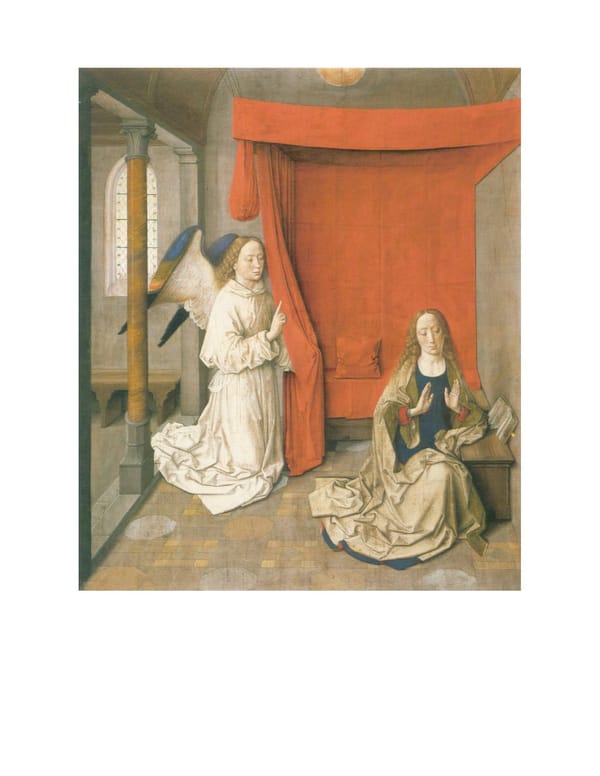

22 Workshop of This panel shows Pope Sergius dreaming that an angel presented him with the miter ROGIER VAN DER and crosier of Saint Lambert (Bishop of Maastricht until his assassination, about 708) WEYDEN and that he would consecrate Saint Hubert to this important bishopric. The papal Flemish, active mid15th cenrury authority for the distribution of offices is reinforced typologically by the stone roundel The Dream of Pope Sergius, above him, which shows Christ consecrating the first pope, Saint Peter. Outside, within circa 1440 a brick enclosure, a lawyer or noble and a Franciscan friar kneel beside the papal retinue Oil on panel and present petitions to Sergius requesting benefits or indulgences. Around the time 89 x 80 cm (35 x 31 ½ in.) 72.PB.20 this panel was painted the pope's right to distribute bishophrics and ecclesiastical offices was directly challenged by the French king and by the Council of Basel. This panel, perhaps, offers visual confirmation of divinely sanctioned papal authority, while the Franciscan may refer to the donor's religious affiliation. In the background, an imaginative effort has been made to recreate a plausible topography for medieval Rome. The round form of the Castel Sant'Angelo appears convincingly depicted on the bank of the Tiber, with Saint Peter's beyond. The obelisk beside the basilica helps to situate the conventional symbols of Rome's landmark buildings into a coherent street plan, making it a very early northern view of an Italian city. The ability to depict objects in minute detail and to create a coherent spatial environment were among the major achievements of Flemish painting in the fifteenth century. The Dream of Pope Sergius and its companion, The Exhumation of Saint Hubert (London, National Gallery), were probably wings from a lost altarpiece that stood in the Chapel of Saint Hubert in the Church of Saint Gudule, Brussels. The chapel was in use by 1440, the period when Rogier was town painter to the city of Brussels (he was appointed before 1435—36). Dendrochronological analysis of the oak panel also supports a date around 1440. Distinctions in quality and spatial conception seem to exclude Rogier's direct participation, and the panel is generally considered to be a product of the master's workshop. DJ DUTCH AND FLEMISH SCHOOLS 45
23 JAN BRUEGHEL At the dawn of the modern era in Europe, there was keen interest in the precise THE ELDER rendering of the natural world, as evidenced by the landscapes and still lifes of Jan Flemish, 15681625 Brueghel. The artist favored smallscale pictures brought to a high degree of finish, The Entry of the Animals into reminiscent of the work of miniaturists. The tonality of his landscapes is quite original, Noah's Ark, 1613 showing brilliantly colored woodland settings that evoke the mood of luxuriant nature. Oil on panel Likewise, the artist had a particular gift for depicting animals. 54.6 x 83.8 cm (21½ x 33 in.) At lower right, signed The story of Noah's ark (Genesis 68) provided a subject well suited to Brueghel's BRUEGHEL FEC. 1613 abilities. Beside a trickling stream that foreshadows the coming deluge, a group of 92.PB.82 curious people watch in wonder as Noah herds the creatures toward the ark. This panel served as the prototype for Brueghel's socalled Paradise Landscapes, in which the artist celebrates the beauty and variety of creation. Brueghel's appointment in 1609 as court painter to Archduke Albert and Infanta Isabella Clara Eugenia enabled him to study exotic animals from life in their menagerie in Brussels. However, the depictions of the lions, the horse, and the leopards were inspired by examples in the works of his great friend and fellow artist Peter Paul Rubens. The lions are depicted in Daniel in the Lions' Den (Washington, D.C., National Gallery of Art); the horse appears in several equestrian portraits from Rubens's Spanish and Italian periods; and the leopards appear in Leopards, Satyrs, and Nymphs (Montreal Museum of Fine Arts). DC 46 DUTCH AND FLEMISH SCHOOLS
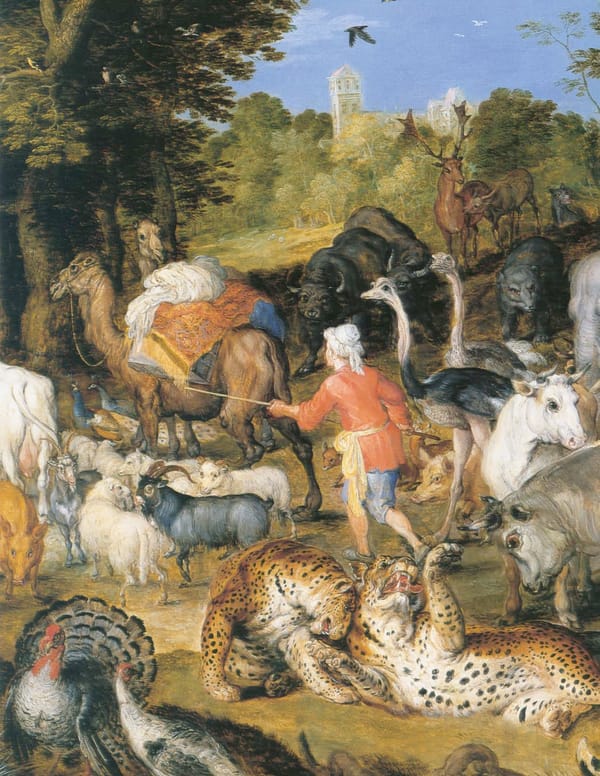
24 JOACHIM WTEWAEL Dutch, 15661638 Mars and Venus Surprised by Vulcan, 160610 Oil on copper 20.25x 15.5 cm (8 x 6 in.) At bottom right, signed JOACHIMWTEN/WAEL FECIT 83.PC.274 This enchanting painting on copper, one of the Museum's smallest and most precious, depicts a story from Ovid's Metamorphoses in which Vulcan, in the company of other gods, surprises his wife, Venus, who is in bed with Mars. Vulcan, on the right, removes the net of bronze, which he had forged to trap the adulterous pair, while Cupid and Apollo hover above, drawing back the canopy. Mercury, standing near Vulcan, looks up gleefully toward Diana while Saturn, sitting on a cloud near her, smiles wickedly as he gazes down on the cuckolded husband. Jupiter, in the sky at the top, appears to have just arrived. Through an opening in the bed hangings, Vulcan can be seen a second time in the act of forging his net. Mythological themes of this kind were especially popular during the sixteenth century, when interest in the classical world reached a peak. This rendering of the infamous legend of Mars and Venus exemplifies the Dutch fascination with human misbehavior, particularly scenes of lecherous misconduct; Wtewael here anticipates the earthy humor of the later seventeenth century. The use of copper as a support for paintings was especially widespread during the late sixteenth and early seventeenth centuries. The very hard and polished surface lent itself to small, highly finished and detailed pictures. Copper was well suited for the present picture, since it allowed for subtler gradations of tone and greater intensity of color than canvas. Fortunately, the painting is in perfect condition and virtually as brilliant as the day it was painted. Due to the erotic subject matter, it may have been kept hidden, and hence protected, over the years. The Museum's painting was probably the one commissioned by Joan van Weely, a jeweler from Amsterdam. BF 48 DUTCH AND FLEMISH SCHOOLS
25 AMBROSIUS BOSSCHAERT THE ELDER Dutch, 1573-1621 Flower Still Life, 1614 Oil on copper 28.6x38.1 cm(11¼ x 15 in.) At bottom left, signed AB.1614. 83.PC.386 Paintings of floral still lifes began to appear at the very end of the sixteenth century in both the Low Countries and in Germany and were linked to a rising interest in botany. Furthermore, the collecting of different types of flowers, already a passion among the Dutch, became virtually a national pastime during the course of the seventeenth century (see no. 38). Middelburg, an important seaport and trading center and the capital of the province of Zeeland, was the center of production. The Middelburg school's founder was Ambrosius Bosschaert, who dedicated his entire career to still-life painting. Still lifes often had symbolic or religious connotations, and flowers were sometimes employed to represent the transitoriness of life or to allude to salvation and redemption. The Museum's still life, painted on copper (see no. 24), contains a basket of flowers with insects; among them are a dragonfly resting on the table nearby and a butterfly perched on a tulip's stem. If the composition at one time suggested a specific meaning to the viewer, it has been lost to us. We can appreciate, however, the freshness of the blossoms and the delicate rendering of detail. As was often the case, the picture contains a number of flowers that could not have bloomed during the same season: roses, forget-me-nots, lilies of the valley, a cyclamen, a violet, a hyacinth, and, of course, tulips. All are arranged in a straightforward and simple manner, with the basket in the center and the single flowers laid out parallel to the picture plane. BF DUTCH AND FLEMISH SCHOOLS 49
26 PETER PAUL RUBENS Recognized as the greatest painter of his day, Rubens received commissions from all Flemish, 1577-1640 over Europe and created profound, original statements of virtually every conceivable The Entombment, circa 1612 subject. Among his greatest contributions to Baroque art were religious paintings that Oil on canvas express emotion with an intensity that has never been surpassed. 131 x 130.2 cm (51 x 51¼ in.) This powerful painting was carefully composed to focus devotion on Jesus Christ's 93.PA.9 sacrifice and suffering. The beautiful corpse is reverentially supported by those closest to him in life. At left is John the Evangelist. Mary Magdalene weeps in the background as her constant companion, Mary, the mother of James the Younger and Joseph, contemplates Christ's wounded hand at right. The viewer is compelled to join the mourners, whose grief is focused in the Virgin Mary, weeping as she implores heaven. Rubens was a devout Catholic, and his paintings give tangible form to the main concerns of his religion. To make religious experience more personally resonant, art followed contemporary meditation, which encouraged the faithful to imagine the physical horror of Christ's crucifixion. Here, the head of Christ, frozen in the agony of death, is turned to confront the spectator directly. Rubens also compels us to regard the gaping wound in Christ's side, placing it at the exact center of the canvas. The composition as a whole, as well as the drawing of the heroic musculature, conveys the languid quality of the subject. The atrocity of crucifixion is not underplayed but is handled with consummate art. Thus, the blood emanating from the wound is created by an eloquent passage of brushwork, lovingly applied with great economy of means. The artist also adds a few symbolic elements to this standard scene of lamentation over the body of Christ. These additions reflect the theological and political concerns of the Counter-Reformation in the early seventeenth century. Thus, the slab on which the body is placed suggests an altar, while the sheaf of wheat alludes to the bread of the Eucharist, the equivalent of Christ's body in the mass. At this time the Roman church was defending the mystery of transubstantiation, the belief in the real presence of the body of Christ in the Eucharist, against Protestant criticism. The allusion to an altar and the eucharistic meaning may indicate that this work was created to serve as an altarpiece in a small chapel, perhaps one dedicated to the adoration of the Eucharist. DC 50 DUTCH AND FLEMISH SCHOOLS
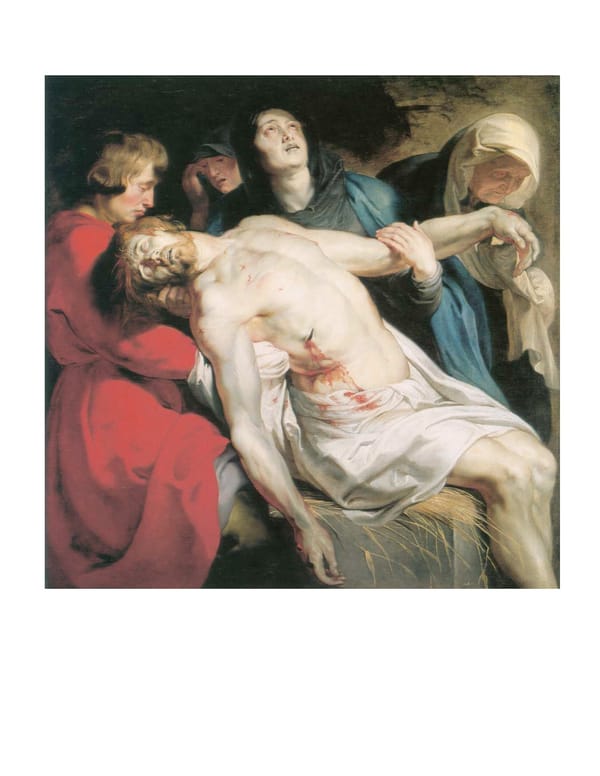
27 ANTHONY VAN DYCK Van Dyck's reputation as an artist was already beginning to spread throughout Europe Flemish, 15991641 when he traveled to Italy in 1621. He initially went to Genoa, where Flemish contacts Agostino Pallavicini, circa 1621 had been established for two centuries, largely because the Genoese had strong Oil on canvas commercial ties to Antwerp, Van Dyck's home. He remained in Italy for five years, 216 x 141 cm (85 x 55½ in.) traveling about to view large private collections of Italian paintings, and during this At top right, near back of chair, us time he was extensively employed to paint portraits. It was in Genoa, however, that signed Ant Van Dyck fecit. 68.PA.2 Van Dyck experienced his greatest successes and executed some of his most famous and impressive paintings. The Museum's portrait depicts a member of the Genoese branch of the Pallavicini family, whose coat of arms may be seen on the drapery to the left, behind the sitter. He is shown in flowing red robes, which almost become the focus of the painting. In his right hand he holds a letter; at one time this must have identified him, but it is no longer legible. From other documented portraits, however, it can be established that this is Agostino Pallavicini (15771649). The writer Giovanni Pietro Bellori, who in 1672 described Van Dyck's stay in Genoa, relates that the artist painted "His Serene Highness the Doge Pallavicini in the costume of Ambassador to the Pope." Pallavicini was not made the doge (the chief magistrate of the Genoese republic) until 1637, but he was sent to Rome to pay homage to the recently elected Pope Gregory XV in 1621, and it is in this capacity that we see him. Thus, the Museum's painting is one of the first executed by Van Dyck after his arrival in Italy. Our presentday image of seventeenthcentury Genoese nobility owes more to Van Dyck than to any other artist, and the Museum's painting typifies the grandeur and stateliness of his portraits. They are usually life size and full length, with a background of pillars and swirling, luxurious draperies. At the time, no other artist in Italy could produce the same grand effect, and the result so enthralled the European nobility that Van Dyck's style eventually set the standard for portraiture in Italy, England, and Flanders. BF 52 DUTCH AND FLEMISH SCHOOLS
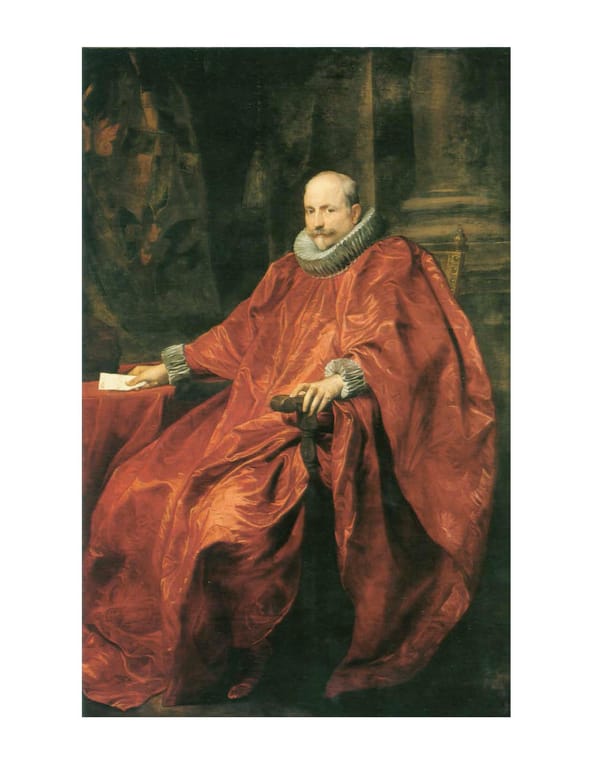
28 ANTHONY VAN DYCK Flemish, 1599-1641 Thomas Howard, The Earl of Arundel, circa 1620-21 Oil on canvas 102.8 x 79.4 cm (40½ x 31¼ in.) 86.PA.532 Thomas Howard, second Earl of Arundel (1585-1646), was one of the great collectors of art and patrons of artists in early seventeenth-century England. With his interests shared by King Charles I, the earl was able to restore the status of his recently disgraced house to its former glory. This portrait attests to Arundel's gifted connoisseurship. Apparently recognizing Van Dyck's talent before most of his contemporaries, he commissioned the work between 1620 and 1621, during the artist's first brief stay in England. It is one of only three surviving paintings from this visit. Arundel is shown as a member of the Order of the Garter; he holds the gold medallion of Saint George (the so-called lesser George), one of the emblems worn by the twenty-four knights who constituted the most eminent and noble men around the king. To the right, with a few broad strokes, Van Dyck has freely evoked a landscape that pays homage to both Arundel's and his own admiration of Venetian painting, especially Titian's late works. Van Dyck's ability to instill his sitters with a sensitive grandeur made him the most famous Flemish portraitist in Europe. This work already heralds his genius, which would later come to epitomize the Stuart court in the 1630s. DJ 54 DUTCH AND FLEMISH SCHOOLS
29 PIETER JANSZ. SAENREDAM Dutch, 1597-1665 The Interior of the Church of Saint Bavo, Haarlem, 1628 Oil on panel 38.5 x 47.5 cm(15 x 18¾ in.) At bottom right, signed P. SAENREDAM F. AD 1628 85.PB.225 First practiced in sixteenth-century Flanders, architectural painting was raised to a highly refined profession by a number of Dutch artists who restricted themselves to this genre. They concentrated on the depiction of churches, which in the Netherlands were relatively unadorned and reflected a rather austere approach not only to religion but to life itself. Saenredam is credited with having begun the tradition in the Netherlands. The earlier Flemish architectural views had largely been exercises in the newly perfected technique of perspective, and the buildings depicted were usually inventions. Saenredam himself trained as an architectural draftsman, and the Museum's painting, inscribed 1628, is the earliest dated example of his work. It is the first of a series of paintings and drawings of Saint Bavo's church in Haarlem. Rather than sketching churches from the nave (the long central hall), Saenredam often stood at more obscure vantage points. He then worked up a finished cartoon, or design, which he transferred directly to a prepared panel. He often made adjustments to the composition, altering architectural details or proportions. One of the two preparatory drawings for the Museum's painting that survive reveals the artist's decision to eliminate three doors at the rear of the transept and replace them with a painted altarpiece. He also rounded the Gothic arches at the sides and added some stained glass. Despite these modifications, the subtle, almost monochromatic coloring, atmosphere, and general flavor of the picture convey a more accurate impression of what it was like to visit a Dutch church than had ever before existed. BF DUTCH AND FLEMISH SCHOOLS 55

30 REMBRANDT In the Metamorphoses (2:833—875), the poet Ovid tells how Jupiter, disguised as a HARMENSZ. VAN RIJN white bull, seduces the Princess Europa away from her companions and carries her Dutch, 16061669 across the sea. Rembrandt evokes the substance and lyricism of this classical story The Abduction of Europa, 1632 by showing Europa as she "trembles with fear and looks back at the receding shore, Oil on panel holding fast a horn... her fluttering garments stream[ing]... in the wind." He also 62.2 x 77 cm (24½ x 30 5/16 in.) enriches Ovid's narrative through his vivid characterization of emotion. Europa, On the brown stone below standing women at lower right, signed stunned by her abduction, turns toward her two companions. The youngest throws RHL van Ryn.1632. up her arms in horror, dropping the garland of flowers that moments ago was destined 95.PB.7 for the bull's neck. Her sudden shock contrasts with the contained sadness of her older companion, who clasps her hands in grief as she rises to look at the princess one last time; only she understands Europa's fate, and it is her gaze that the princess meets. Rembrandt's comedic sense lightens the drama. Jupiter, limited by his disguise, expresses victory in bovine fashion by excitedly extending his tail as he plunges from the shore. Jupiter's reaction is in sharp contrast to the passive, mindless horses who stand harnessed to the princess's grandiose and immobile carriage. Seemingly too large for the road, and with its sunshade uselessly open in the shadows, the carriage contrasts with the swift white bull who carries Europa into the light toward the new continent that will one day bear her name. A luminous landscape also acts as a protagonist in this drama. The meticulously detailed, dark, walllike stand of trees serves as a foil to the loosely handled, lightshot, pink and blue regions of sea and sky. The unusually low horizon creates an expansive vista where clouds, shore, and sea gently roll toward each other. Along the horizon, shrouded in mist, is Tyre, the city forsaken by Europa. The carriage's glittering gold highlights and the richly varied textures of the sumptuous costumes show Rembrandt both delighting in his mastery of visual effects and inviting the viewer to share his pleasure in detail. The sea's glowing reflections, the spray tossed up by the wellclad princess's shoe skimming through the water, and her delicate grasp of the soft flesh of the bull's neck captivate the eye and linger in the mind. The painting shows the young artist working at the height of his powers upon his arrival in Amsterdam in 1632. DA DUTCH AND FLEMISH SCHOOLS 57
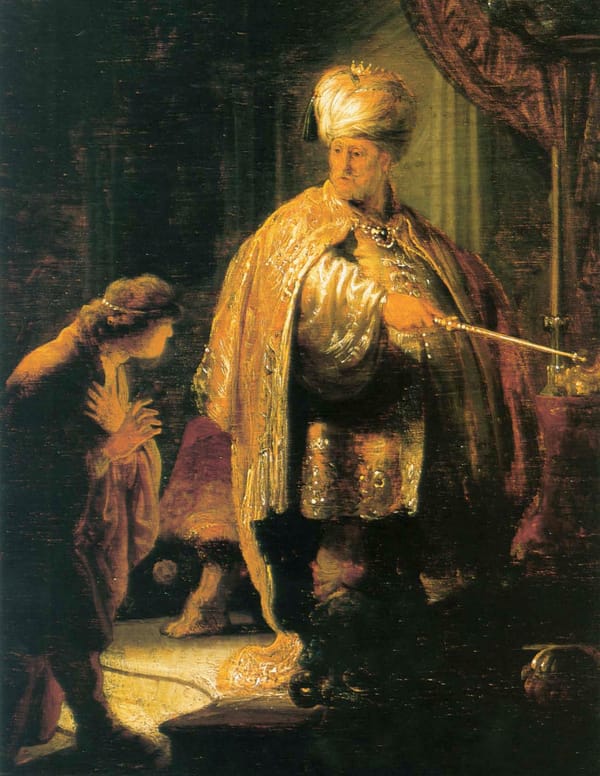
31 REMBRANDT HARMENSZ. VAN RIJN Dutch, 1606-1669 Daniel and Cyrus Before the Idol Bel, 1633 Oil on panel 23.4 x 30.1 cm (9¼ x 11 in.) On the dais at lower right, signed Rembrant f. 1633. 95.PB.15 Rembrandt depicts an episode from the apocryphal Book of Daniel that tells of Daniel's unmasking of idolatry at the court of Babylon, where he has become a confidant of King Cyrus the Persian. When Cyrus asks him why he does not honor the deity Bel, Daniel replies that he worships the living God, not an idol. Here, the king insists that Bel, too, is a living god, indicating the lavish offerings of fine food and wine he provides for Bel's consumption each night. Daniel gently points out that bronze statues don't eat. While Cyrus is momentarily bewildered, the worried face of the priest in the background confirms that Daniel is on to something. Rembrandt evokes the exotic mystery of a pagan cult by showing only part of the monumental idol emerging from the flickering lamplight. A shaft of light focuses on the human interaction at the heart of the narrative. Rembrandt captures Cyrus's confusion perfectly, but we do not even see Daniel's face; his body language tells us all we need to know. Perhaps the most poignant aspect of Rembrandt's interpretation is his ironic contrasting of the large, powerful king with the small, humble boy sent by God. Rembrandt created this painting the year after The Abduction ofEuropa (see previous entry). Both works demonstrate his genius as a storyteller and his evolution toward more concise, dramatically focused compositions and broad, free handling of paint that are hallmarks of his mature style. DC DUTCH AND FLEMISH SCHOOLS 59
32 REMBRANDT This painting is one of a series of portraits of the apostles that bear the date 1661. HARMENSZ. VAN RIJN The portraits were apparently not meant to be hung together, as they are of varying Dutch, 1606-1669 sizes, and it is unlikely that the artist ever depicted all twelve of Christ's disciples. The Saint Bartholomew, 1661 existence of this series suggests that Rembrandt was perhaps personally preoccupied Oil on canvas with the apostles' significance at this time, just eight years prior to his death. 86.5 x 75.5 cm. (34 x 29¾ in.) Each of the known portraits gives the impression of having been painted from a At bottom right, signed Rembrandti'f.1661 model, probably a friend or neighbor, a practice that Rembrandt normally followed. 71.PA.15 The idea that a common man could be identified with a biblical personage and thereby lend a greater immediacy to Christ's teachings would have been in keeping with the religious atmosphere in Amsterdam at the time. Saint Bartholomew is represented with a mustache and a broad, slightly puzzled face. The stolid, rather pensive, and very ordinary men that Rembrandt often chose as models for these paintings would not be precisely identifiable as individual saints were it not for the objects they hold in their hands—in this case a knife, a traditional attribute referring to the fact that Bartholomew was flayed alive. Their clothing, which in its simplicity is meant to connote biblical times, is very different from the crisp collars and suits worn by the seventeenth-century Dutch upper classes. Saint Bartholomew is rendered in the broader, freer style of the artist's late maturity. He has used palette knives and the blunt end of his brushes in depicting the saint, and his technique is much more direct than that of any of his contemporaries. The history of the interpretation of the Museum's painting is of some interest. In the eighteenth century it was thought to depict Rembrandt's cook, in keeping with the taste for everyday subjects, especially servants and humble occupations, that characterized French art of the time. In the nineteenth century, a period enamored of dramatic or tragic themes, the saint was thought to be an assassin, a reading to which the knife and the subject's intense look no doubt contributed. BF 60 DUTCH AND FLEMISH SCHOOLS

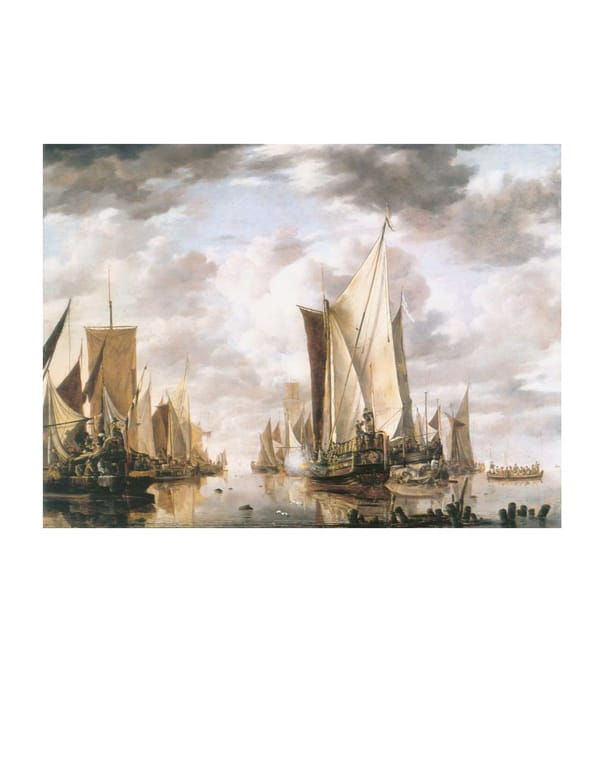
33 JAN VAN DE CAPPELLE By the mid-seventeenth century the Dutch republic had reached its height of power as Dutch, 1625/26-1679 a global trading empire, and its domination of the seas found expression in the nascent Shipping in a Calm at Flushing specialization of marine painting. In 1649, Jan van de Cappelle and Simon de Vlieger with a States General Yacht changed the course of Dutch seascapes with their innovation of the "parade" picture, Firing a Salute, 1649 in which grand ships convene for special occasions under towering, cloud-filled skies. Oil on panel In Shipping in a Calm a stately yacht fires a salute to announce the arrival of a 69.7 x 92.2 cm (27 x 36¼ in.) 96.PB.7 dignitary, who is conveyed to shore in the launch at right. Apparently unaffected by the sound, several porpoises glide peacefully through the calm waters. They were known to frequent Flushing (Vlissingen), the busy port used by the Dutch East India Company that was frequently portrayed in Van de Cappelle's paintings. As one of his earliest known signed and dated works, this painting displays Van de Cappelle's highly developed style and remarkable technical virtuosity. The painter demonstrates an accomplished graphic handling of form in the detailed ships, rigging, and sails and his mastery of atmospheric and optical effects in the treatment of reflections in the water. This dramatic avenue of ships framing an infinite vista of the sea and their close and dominating viewpoint are pioneering contributions to the genre of marine painting. AFK DUTCH AND FLEMISH SCHOOLS 63
34 JACOB VAN RUISDAEL Dutch, 1628/29-1682 Two Water Mills and an Open Sluice, 1653 Oil on canvas 66 x 84.5 cm (26 x 33¼ in.) At bottom left, signed JVR [in monogram] 1653 82.PA.18 Since the seventeenth century Jacob van Ruisdael has been recognized as the Low Countries' most important landscape painter. He is credited with transforming the tradition of landscape painting into one based more closely on the observation of natural detail. He had already established his reputation at the age of nineteen, and Two Water Mills and an Open Sluice, executed when he was scarcely twenty-five, is a strong indication of how rapidly his style matured. During the early 1650s Ruisdael made a trip to Westphalia and en route, he apparently saw some water mills at Singraven, a town in the Dutch province of Overijssel. Subsequently, he painted a series of views of these mills; the Museum's canvas is one of six known variations and the only one that is dated. A comparison of the six versions reveals that the artist did not hesitate to rearrange the setting and some details of the mills in order to enhance his composition. While the general appearance of the rough buildings remained the same, Ruisdael felt free to add small sheds on the side or to alter the shape of the roof and give it a different profile. Similarly, he moved trees around and added hills—such as the one at the right between the two mills in the Museum's landscape—to lend variety to the topography, which in reality was flat. Ruisdael preferred this way of working during this phase of his career, and although his views are topographically accurate in many respects and indicate a close study of nature, he did not consider himself bound to represent every landscape element exactly as it appeared. Later in life he helped satisfy the popular demand for more exotic landscapes by painting views of waterfalls—evidently inspired by paintings and drawings of Scandinavia. These works drew more heavily upon the artist's imagination. Initially, however, he felt relatively more constrained to paint what he saw. The Museum's painting is a rendering of one of the few sites where Ruisdael might have actually seen rushing water. It is a marvelously atmospheric depiction. BF 64 DUTCH AND FLEMISH SCHOOLS
35 PAULUS POTTER Dutch, 1625-1654 The Piebald Horse, 1650-54 Oil on canvas 49.5 x 45 cm (19½ x 17¾ in.) At lower left, signed Paulus Potter f. 88.PA.87 Paulus Potter was the most innovative and influential of Dutch animal painters. In his hands, cows and horses became the focus of paintings, rather than mere accessories in a larger scene. Here, standing majestically on a slight rise, a spotted stallion dominates an expansive landscape. By placing the horizon line along the bottom third of the picture, Potter gives the magnificent steed an almost heroic monumentality. The head is captured in full profile, dramatically silhouetted against sweeping cloud formations. In the middle distance, a gentleman on horseback, accompanied by a groom and dogs, returns to his country house at right. Potter's depiction of the animal is so closely observed that it should probably be considered a portrait of a prized possession of this landowner. Potter is said to have wandered the Dutch countryside, sketchbook in hand, studying his subjects. His ultimate success derives from his arresting sympathy for the beasts he depicts. He not only finds great beauty in their shining coats and manes, but also manages to suggest character and emotional complexity. Here, the horse seems sensitive and alert, as if responding to the distant sound of the hunt. Potter suggests that, while we may tame and control such animals, we can never fully understand their special world. In his Painter's Book of 1604, the art theorist Karel van Mander told how the greatest painter of antiquity, Apelles, depicted horses so realistically that actual horses whinnied and snorted at the sight of them. In works such as The Piebald Horse, Potter must have sought to rival his ancient forebear. His vision and skill are all the more remarkable when one realizes that he died of tuberculosis at age twenty-nine, but not before profoundly influencing the depiction of animals in western art. DC DUTCH AND FLEMISH SCHOOLS 65
36 JANSTEEN Dutch, 16261679 The Drawing Lesson, circa 1665 Oil on panel 3 49.3 x 41 cm (19/sx 161/4 in.) At bottom left, signed JStein [the first two letters in monogram and the last three letters uncertain] 83.PB.388 In The Drawing Lesson, an artist demonstrates drawing to a young boy and a teenage girl. The painting presents an unusually detailed view of an artist s studio. On the table are brushes, pens, and charcoal pencils. Hanging over the table's edge is a woodcut by the Dutch artist Jan Lievens, depicting the head of an old man and dating from about 164055. Next to the drawing stand is a plaster cast of a male nude, and hanging from the wall, shelf, and ceiling are a number of other plasters. On the shelf is a sculpture of an ox, the symbol of Saint Luke, the patron saint of painters (see no. 1). In the background are an easel with a painting on it and a violin hanging on the wall. In the foreground are a stretched canvas, an album of drawings or prints, a carpet, a chest, and other objects that might be used in a still life. Some of the objects in the foreground—a laurel wreath, a skull, wine, a fur muff, a book, a lute, and a pipe—are related to the traditional theme of vanitas (referring to the transience and uncertainty of life), which is often found in Dutch still lifes. Steen did not paint still lifes as such, and the grouping together of so many of these objects suggests that their presence is more than accidental. In fact, he is most famous for his depictions of human foibles and misconduct and often portrayed himself and others as drinkers or boastful fools. He rarely failed to point out the folly of this behavior, however. The accumulation of so many traditional symbols of worldly conceit in The Drawing Lesson may indicate that Steen felt the artist's role at least in part to be that of a social commentator. The Museum's painting becomes, therefore, a kind of allegory of his own profession. The Drawing Lesson has survived to this day in remarkable condition. It is rare for a panel painting to have escaped drastic and damaging cleanings, and the detail and subtleties of this composition, which are present to a degree rarely found in the artist's work, are all very much intact. BF 66 DUTCH AND FLEMISH SCHOOLS
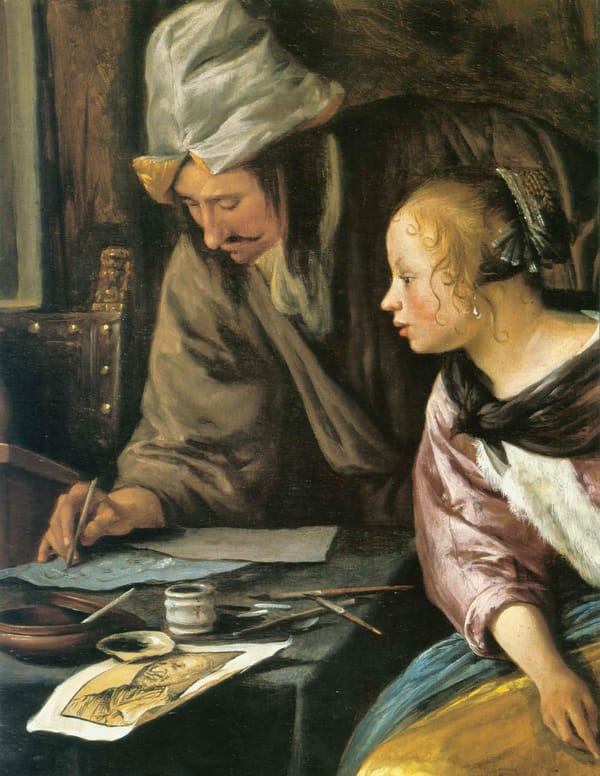

37 PHILIPS KONINCK During the seventeenth century, Dutch artists specialized to an almost unprecedented Dutch, 16191688 degree, and most of them attempted the refinement of just one or perhaps two subjects. Panoramic Landscape, 1665 More painters were devoted to the art of landscape painting than to any other, and Oil on canvas within this genre each artist had his own specialty—for example, forest scenes, 138.4 x 167 cm (54½ x 65½ in.) cityscapes, or Italian views. At bottom right, signed P Koninck 1665 Perhaps the most unusual of these landscape types was the panoramic view. While 85.PA.32 Dutch art in general is noted for its love of nature and close observation of naturalistic detail, the panoramic landscape generally assumes a point of view high above the earth, as if the artist were at the top of a mountain from which he could see the otherwise flat landscape stretching away to the horizon. Because the artist in Holland had no such vantage point (with the possible exception of church towers and ships' masts), he was forced to imagine the entire scene. The clouds, of course, could be painted from any spot, but even the clouds tend to be highly picturesque in such views and are probably the result of considerable invention. Panoramic landscapes were painted in the sixteenth century but not in great numbers. The idea was revived by the Dutch painter Hercules Seghers (1589/90 circa 1638), and Rembrandt also painted a few; these landscapes are among the most inventive and individual productions of both artists. It was, however, Philips Koninck, probably a student of Rembrandt, who developed the genre to its fullest form, making it his own specialization. The thick brushwork and strong contrasts between areas of light and shade in the Museum's painting—one of Koninck's masterpieces—are strongly reminiscent of Rembrandt. The naturalism evident in the treatment of the sky, however, is quite unlike the older artist's manner. The aesthetic issues raised in a picture of this kind are extremely provocative. Few other artists dared to divide the canvas almost exactly in half with a single straight, unbroken horizon line. The problem of effectively combining the two halves is one that Koninck deliberately posed for himself, and its solution lends a drama to the subject that few other landscapes possess. BF DUTCH AND FLEMISH SCHOOLS 69
38 JAN VAN HUYSUM Perhaps more than any other artist, Jan van Huysum reflects the Dutch fascination Dutch, 1682-1749 with nature and its myriad details. He worked at a time when the Dutch republic was Vase of Flowers, 1722 already past its so-called golden age and had acquired the sophisticated taste and love Oil on panel of embellishment that we associate with the Rococo period in France. Van Huysum's 79.5 x 61 cm (31¼ x 24 in.) work reflects this change in taste while retaining a fidelity to subject matter that was On ledge, signed JAN VAN HUYSUM FECIT 1722 part of an established Dutch tradition. 82.PB.70 Van Huysum invariably included many different kinds of flowers in his pictures, often recently bred or newly acquired specimens brought to him by Amsterdam's avid flower collectors. Enormous sums of money were spent on flowers at the time, and the circle of connoisseurs surrounding Van Huysum could well appreciate his ability to depict them so exactly. The details of his highly finished technique were a jealously guarded secret. The composition of Vase of Flowers is relatively straightforward. The vase is centrally placed with no more background than a slanting ray of light, which sets off the bouquet. Another Van Huysum painting in the Museum's collection, which depicts both flowers and fruit, is also dated 1722 and may be a companion piece. The second picture, however, is composed asymmetrically; fruit flows over the ledge upon which it has been placed, some of the grapes and the pomegranate are already bursting and overripe. Although these features may simply be intended to evoke a luxurious standard of living, they may also be meant to contrast with the unspoiled quality of Vase of Flowers. BF Fruit Piece, 1722 Oil on panel 79.5 x 61 cm (31¼ x 24 in.) 82.PB.71 70 DUTCH AND FLEMISH SCHOOLS
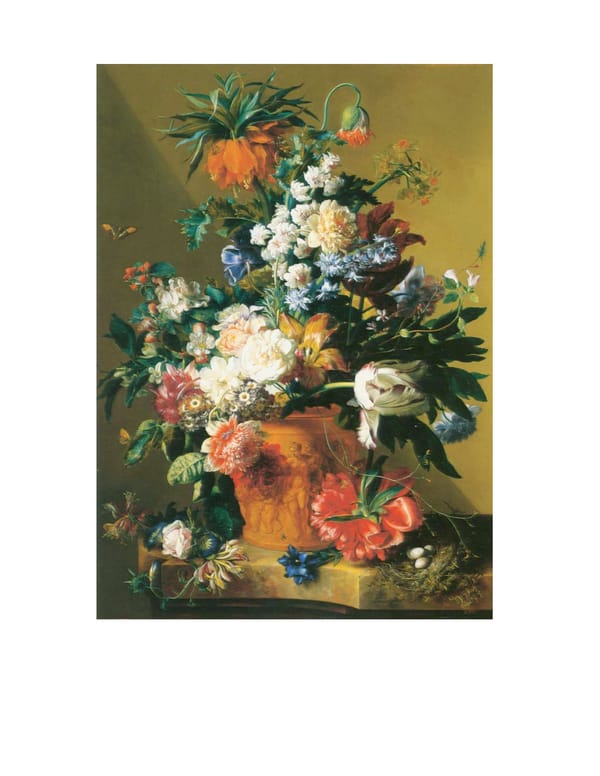
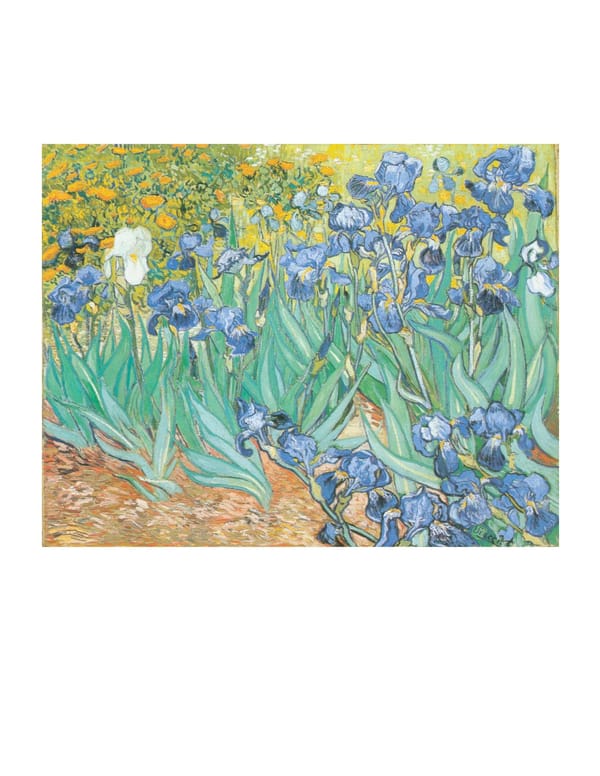
39 VINCENT VAN GOGH The episodes of selfmutilation and hospitalization that followed his quarrel with Paul Dutch, 18531890 Gauguin finally prompted Van Gogh to have himself admitted in May 1889 to the Irises, 1889 asylum SaintPauldeMausole in SaintRemy de Provence, France. Despite occasional, Oil on canvas disturbing recurrences, Van Gogh produced almost 130 paintings during his year of 71 x 93 cm (28 x 36 in.) recuperation in SaintRemy. Although he was not permitted to leave the grounds for At lower right, signed Vincent 90.PA.20 the first month, the overgrown and somewhat untended garden of the asylum provided ample material for his paintings, which he worked, as was his practice, directly from life. In the first week Van Gogh reported to his brother Theo that he had begun work on "some violet irises." That Van Gogh was deeply affected by the regenerative powers of nature comes across clearly even in this limited view. There is a muscularity to the blueviolet blooms supported on their sturdy stems amid swaying, pointytipped leaves that almost forcefully push their way through the red earth. Even the contemporary critic Felix Feneon described the Irises in anthropomorphic terms, although he saw destruction rather than renewal in the image: "The 'Irises' violently slash into long strips, their violet petals on swordlike leaves." Incorporating lessons learned from Pointillist color theory, Impressionist subject matter, and Japanese woodblock printmakers, Van Gogh distills the garden patch into patterned areas of vivid color. The composition, with its impastoed brushwork intact and unfaded, is bisected horizontally by waving bands of cool green leaves. Above, the varied clumps of violet petals (set off by a lone white iris) are placed in contrast over the warm green ground of the distant, sunlit meadow. Below, the same violet shades reverberate in juxtaposition with the redbrown of the Provencal soil, built up with striated parallel brushstrokes. The cropped nature of the composition most likely led Van Gogh to describe the Getty canvas as a study after narure rather than a finished painting in a letter to his brother. Nevertheless, among the eleven canvases he received in July, Theo chose only the Irises to accompany the earlier Starry Night (New York, Museum of Modern Art) as Van Gogh's submission to the Salon des Independants in September 1889. PS DUTCH AND FLEMISH SCHOOLS 73
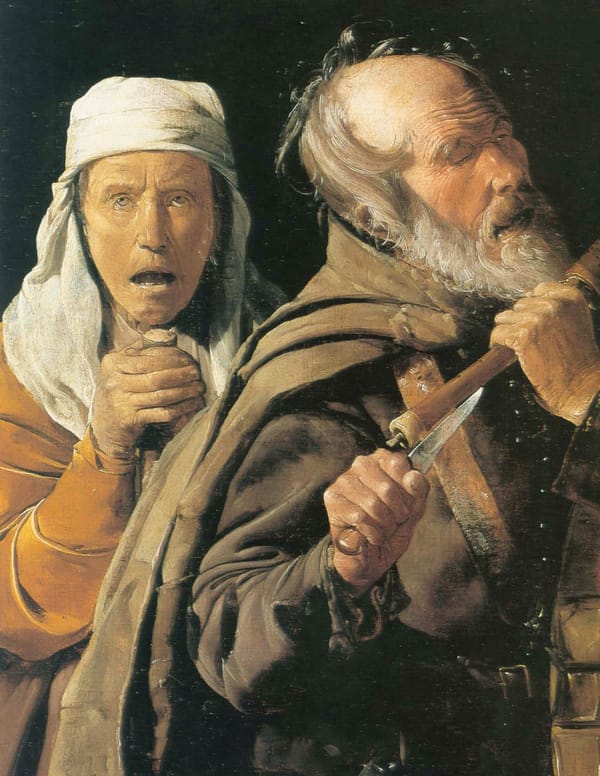
40 GEORGES DE LA TOUR The subject of The Beggars' Brawl is the fight of two elderly itinerant musicians over a French, 1593-1652 place to play their instruments. The man on the left, with a hurdy-gurdy slung around The Beggars' Brawl, his shoulders, is defending himself with a knife and the crank of his instrument. He is circa 1625-30 menaced by another man who seems to be hitting him with a shawm, a kind of oboe, Oil on canvas and who wears a similar instrument at his waist. The second beggar squeezes the juice 85.7 x 141 cm (33¾ x 55½ in.) of a lemon into his opponent's eyes, either to test whether the man with the hurdy- 72.PA.28 gurdy is truly blind or simply to further agitate him. On the left an old woman seems to implore someone to help. At the right two more beggars, one with a violin and the other with a bagpipe, enjoy the fight. The subject is a rare one; many seventeenth-century artists painted peasants or musicians, but depictions of quarrels among them are hardly ever found. One of the few examples is a print by the French artist Jacques Bellange that may have supplied the inspiration for the Museum's painting. La Tour used motifs from Bellange's prints on other occasions and obviously admired him. La Tour spent his life in Lorraine in eastern France and is not known to have ventured far from there. His style, therefore, is based upon whatever works he might have seen in or near the relatively small city of Luneville where he lived, and it is not surprising that prints should have been a major source of his inspiration. The violinist on the right in the Museum's painting may in fact be derived from a print by the Dutch artist Hendrick ter Brugghen, which depicts a grinning man in a striped coat holding a violin and wearing a feathered cap. The print probably dates from the mid-to-late 1620s, as does La Tour's painting. In a more general way La Tour's work belongs to the realist tradition that swept Europe in the aftermath of the very revolutionary pictures painted by Caravaggio in Italy. It is doubtful that La Tour ever saw any original paintings by Caravaggio, but the desire for a renewal of naturalism in painting was so strong that it quickly found adherents everywhere. BF FRENCH SCHOOL 75
41 SIMON VOUET In the tale of Venus and Adonis (Metamorphoses 10: 532—709), Ovid describes both French, 1590-1649 the power and the limitations of love. Venus, stricken with passion for the beautiful Venus and Adonis, circa 1640 huntsman, renounces the comforts of heaven and "with her garments girt to her knees" Oil on canvas ranges through the forest to be near Adonis. She fears the dangers of the hunt, warning 130x94.5 cm (51¼ x 37¼ in.) him that "against bold creatures, boldness is not safe." But the love that transformed 71.PA.19 Venus herself is powerless to change Adonis. He forsakes her for his greater passion of the chase, only to die, as she had foreseen. Like other Baroque masters, Vouet's earlier treatments of this subject were deeply indebted to Titian, whose Venus and Adonis (no. 15) shows the hunter fleeing the goddess's desperate embrace. In this late work Vouet illustrates the poignant earlier moment when love is briefly won. In the painting, as in the text, the weary goddess reclines beneath the shade of a poplar tree. She will soon draw Adonis toward her and tearfully admit both her love and her fears. The consummation of their meeting is gently alluded to by the nestling doves and by the winged putti who prepare to cast flowers as they pivot above the pair. Vouet was one of the founders of the French Baroque. The first half of his career was spent principally in Rome (1612—27), where he was the only foreigner to receive honors usually accorded Italian artists. After being recalled to France by Louis XIII, Vouet replaced his vigorous, dramatic Caravaggist style with a sensuous classicism that complements the rigorously cerebral approach of his contemporary Poussin. In the Venus and Adonis rhythmic line, sunny color harmonies, and swinging, fluid brushwork evoke the poetic cadences of Ovid. Vouet's interpretation appealed to the cultured audience who appreciated the poignant evocation of the story's subtle moral dimensions. As the legend on the print (1643) made after this work tells us, "You are astonished, Adonis, to find yourself in the arms of Venus; and you ignore how close are the terrible fangs of the wild boar." DA 76 FRENCH SCHOOL
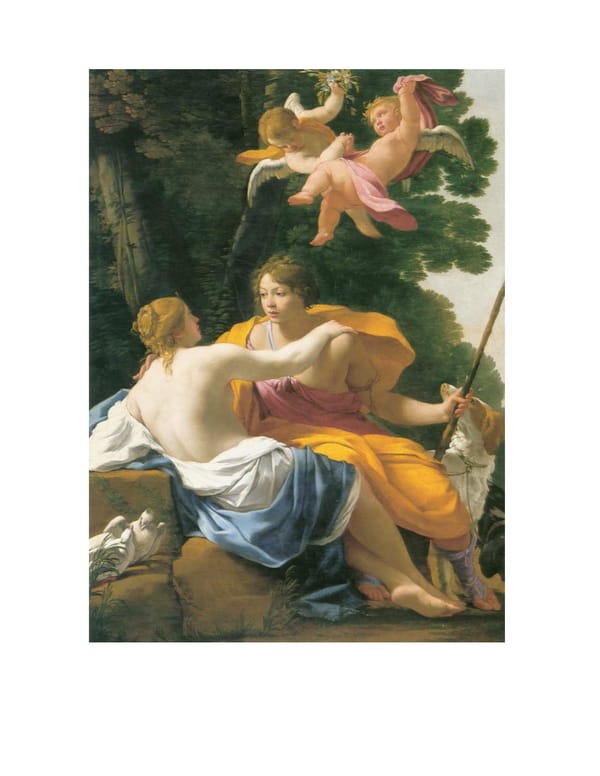
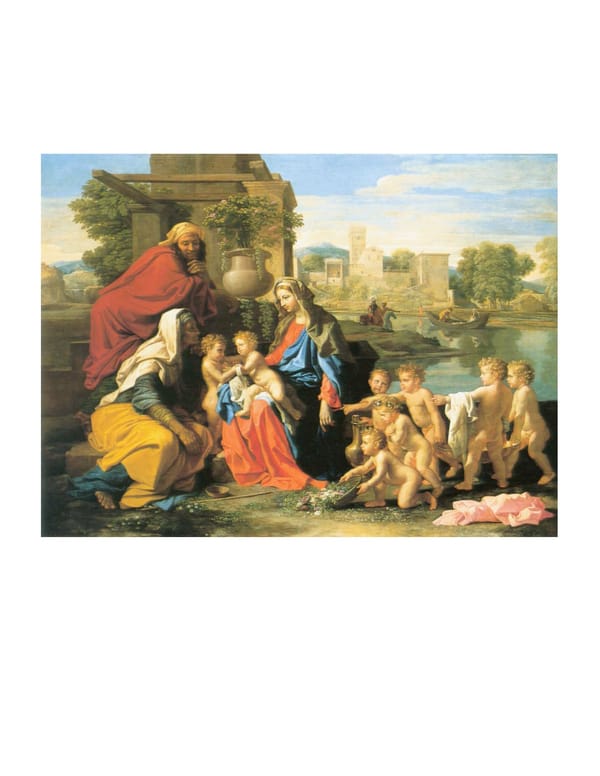
42 NICOLAS POUSSIN Of the many foreign artists who worked in Rome, Poussin was probably the most French, 15941665 famous. Even in his own time, he was revered as a master. Like Valentin before him, The Holy Family, 1651 Poussin spent nearly his entire adult life in the papal city. The contemporary Italian Oil on canvas biographer Bellori wrote: "France was his loving mother, and Italy his teacher and 96.5 x 133 cm (38 x 52 in.) second fatherland." The artist drew inspiration from his Roman surroundings and 81.PA.43 Owned jointly with the Norton became the fountainhead of the classical tradition in seventeenthcentury Italy, Simon Art Foundation, Pasadena profoundly influencing the art not just of his adopted land but of all of Europe. Later in life, Poussin painted a large number of religious themes, in particular several depicting the Holy Family. The Museum's painting, probably the most beautiful and ambitious of these works, includes Christ, Mary, and Joseph as well as the infant John and his mother, Elizabeth. The action focuses on the embrace of John and Jesus; the ewer, towel, and basin of water held by the group of putti (infant boys) at the right may refer to the bathing of the Child or to John's later baptism of Christ. The painting is composed in a highly classicizing vein and exemplifies Poussin's very rationalistic inclination. He often placed figures in a setting so meticulously composed that it seems to have a geometric underpinning. In contrast to the "realism" of the Caravaggesque painters, whose popularity had faded by this time, Poussin normally used fairly strong color and placed his subjects in idyllic settings bathed in bright light. The figures hark back to those of Raphael (14801520), the model for most classicizing artists of later centuries, and the landscape derives from the Venetian tradition of Giorgione (circa 1476—1510) and Titian (circa 1480—1576). The Museum's painting was commissioned in 1651 by Charles III de Blanchefort, due de Crequi, one of the many wealthy patrons who competed for Poussin's pictures. The duke's grandfather was the French ambassador to Rome under Louis XIII, the first Frenchman to have bought a work from Poussin and an important figure in spreading the artist's reputation in France. Continuing the tradition, the duc de Crequi, who was himself to be appointed ambassador to Rome under Louis XIV, became one of Poussin's most important collectors. BF FRENCH SCHOOL 79
43 JEANFRANCOIS DE TROY French, 16791752 Before the Ball, 1735 Oil on canvas 9 81.8 x 65 cm (32 x 25/16 in.) At bottom right, signed De Troy 1735 84.PA.668 De Troy was one of eighteenthcentury France's most versatile artists. The son of a wellknown portrait painter, he came to excel not only in that field but also in the painting of historical, mythological, and religious subjects. He worked successfully in both large and small scale, and his works, like those of Watteau (1684—1721), vividly convey the elegance and sophistication characteristic of fashionable Parisian society of the time. The Museum's painting, along with its companion piece, The Return from the Ball (now lost, but known from an engraving), was painted in 1735 for Germain Louis de Chauvelin, the minister of foreign affairs and keeper of the seal under Louis XV. When De Troy exhibited them in the Salon of 1737, the pair was declared to be the artist's finest work. Before the Ball typifies De Troy's tableaux de mode, depictions of the aristocratic class at home and at leisure. These paintings are now considered to be among the most significant of the artist's works. In the Museum's painting a group of men and women watch a maid put the final touches on her mistress's hair. The onlookers are already wrapped in cloaks and hold masks in eager anticipation of the evening's festivities. At the time, some critics disapproved of the lifestyle celebrated by such paintings, but De Troy apparently moved easily in fashionable circles and does not appear to have been moralizing about the vanity of the aristocratic behavior. On the contrary, he seems to have relished it and to have well understood its nuances and conventions. He has succeeded in capturing the slightly charged and even erotic climate of the proceedings, and there is a certain realism in his observation that betokens a clear and acutely perceptive eye. BF 80 FRENCH SCHOOL
44 JEANBAPTISTE GREUZE French, 17251805 The Laundress, 1761 Oil on canvas 40.6 x 32.4 cm (16 x 12 7/8 in.) 83.PA.387 During the last half of the eighteenth century, Greuze was the most famous and successful exponent of genre painting in France. He normally chose themes with strong moralistic overtones, the closest parallels to which were to be found in the contemporary theater rather than in the work of his fellow artists. At a time when the academies extolled history painting as the highest form of the art, Greuze attempted to raise his more mundane subject matter to a comparable level of importance. Like other French artists before him, Greuze was inspired by the study of the seventeenthcentury Dutch and Flemish pictures that were extensively collected and admired in France during the eighteenth century. Many of his subjects are in fact taken directly from the works of Dutch and Flemish artists, who were the first to concentrate on depictions of working people and servants. In the 1730s the French artist Chardin had painted a similar laundress, and Greuze was no doubt familiar with his picture. Chardin emphasized the humility and quiet dignity of his subject, but Greuze chose to give his laundress a provocative glance and to stress her disheveled appearance. By exposing her ankle and foot, the artist imparts a suggestion of licentiousness to the young woman. With other details of her clothing and the disorderly setting—which would have been much more readily interpreted by his contemporaries than by modern viewers—he further warns against the girl's tempting glance. The Laundress was exhibited in the Salon of 1761, the year Greuze first achieved success, and the critic Denis Diderot, one of the artist's first prominent admirers, described the girl in the painting as "charming, but... a rascal I wouldn't trust an inch." Soon after its first exhibition, the Museum's painting was acquired by the collector Ange Laurent de La Live de Jully, the artist's most important patron during this period. BF FRENCH SCHOOL 81
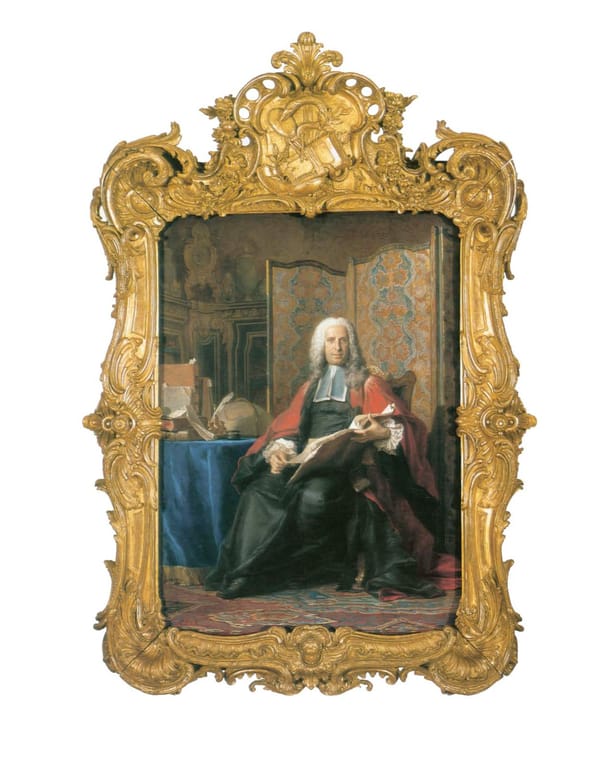
45 MAURICEQUENTIN MauriceQuentin de La Tour was the most soughtafter portraitist of his day. He worked DE LA TOUR exclusively in pastel, producing likenesses of the nobility and the wealthy middle class that French, 17041788 were acclaimed both for their technical mastery and for their brilliant verisimilitude. After Gabriel Bernard de Rieux, seeing Gabriel Bernard de Rieux at the Salon of 1741 a viewer wrote, "It is a miraculous circa 173941 work, it is like a piece of Dresden china, it cannot possibly be a mere pastel." Pastel and gouache on paper This monumental fulllength portrait—assembled from separate sheets of paper mounted on canvas Unframed: 200 x 150 cm laid on canvas and still in its original, massive gilt frame—transcends the intimate (79x 59 in.) conventions of the pastel medium. During his long career La Tour did only one other Framed: 317.5 x 223.5 cm like it, the portrait of Madame de Pompadour now in the Louvre. The Getry portrait (125 x 88 in.) 94.PC.39 illustrates a fine differentiation between textures, a play of light over reflective surfaces, and an overall high degree of finish extraordinarily difficult to achieve in fragile pastel. This work was perceived by contemporaries to be La Tour's greatest technical success, rivaling portraits in the more prestigious medium of oil. Gabriel Bernard de Rieux (1687—1745) is shown dressed in the robes of his office as president of the second Court of Inquiry in the Parliament of Paris. He owed his status as a member of the extremely wealthy class known as the grande bourgeoisie to his father, an immensely successful financier, who also purchased the noble title of the comte de Rieux in 1702. Gabriel Bernard inherited his father's fortune in 1739, the year this work was begun. The deliberately oldfashioned furnishings and Gabriel Bernard's poised hauteur create the aura of old wealth and status, a fiction delightfully undone by the brazen grandeur of his portrait. In this work the high ambitions of a patron and an artist, who was said to produce a new marvel of perfection every year, seamlessly coincide. DA FRENCH SCHOOL 83
46 THEODORE GERICAULT French, 17911824 The Race of the Riderless Horses, 1817 Oil on paper laid on canvas 7 19.9 x 29.1 cm (7 13/16 x 11 /16 in.) 85.PC.406 In 1817, Gericault witnessed the annual carnival race of the Barberi horses down the Via del Corso, one of the major avenues of Rome. Gericault was intrigued by the artistic possibilities offered by the event, which involved grooms goading the animals into a frenzied stampede along the crowded streer. His oil sketches show how he took a contemporary scene and gradually mythologized the action, so that the startingline grooms became nude athletes poised before a classical portico. Scholars had long been interested in trying to demonstrate how modern festivals and games preserved ancient Roman customs. However, Gericault was probably wrestling with ways of translating the excitement of the race into a classical pictorial language suitable for the Paris Salon. Gericault had already established himself as a brilliant painter of horses in motion, and here the dramatic struggle between man and beast serves as the focus of this oil sketch. The broad blocking in of forms and almost monochromatic appearance suggest that achieving tonal balance within the composition was among Gericault's chief concerns. He has successfully translated his favored medium of pen and wash into thick, swirling paint, as if he were recarving the ancient basrelief sculpture that so influenced him. Virtuoso preparatory oil sketches were part of a French artist's academic training, but sadly, Gericault never developed this vivid scene into a grand Salon painting. DJ 84 FRENCH SCHOOL
47 THEODORE GERICAULT French, 1791-1824 Three Lovers, circa 1817—20 Oil on canvas 22.5 x 29.8 cm (8 x 11¾ in.) 95.PA.72 In this remarkable sketch Gericault has depicted his subject with unabashedly modern directness, capturing the energy of human behavior and its awkward intensity in a way completely different from the idealizing conventions of his age. The woman straddling her lover wears everyday clothes, and her hair is arranged in the latest style. Her single dangling stocking is also a contemporary detail, although its presence here has less to do with fashion than with urgency. Her provocatively exposed, pivoting leg, which barely brushes the edge of the platform, draws attention to the unsustainable torsion of her pose. The couple seems to be supported only by the coiled energy of their interlocked embrace and by their passionate eye contact. At the left, the pair's languid female companion calmly observes their elusive moment of engagement. Her nudity and relaxed pose evoke the way the classical tradition represented repose after lovemaking; her torso artfully complements the statue of Venus above. The sculpture, the drawn curtain, the bold lighting, and the spatial partitions provide a theatrical setting for this naturalistic presentation of passion. The Three Lovers is an independent, finished sketch, small in scale and intended for close private viewing. The sketch technique unites the emotional immediacy of the subject with the dramatic spontaneity of the artist's touch. Gericault delights in the tight draftsmanship of his brushwork, describing an attenuated finger or strand of hair as deftly as the dragged folds of cloth. Although the artist often drew such subjects, this is his only known erotic painting. DJ FRENCH SCHOOL 85
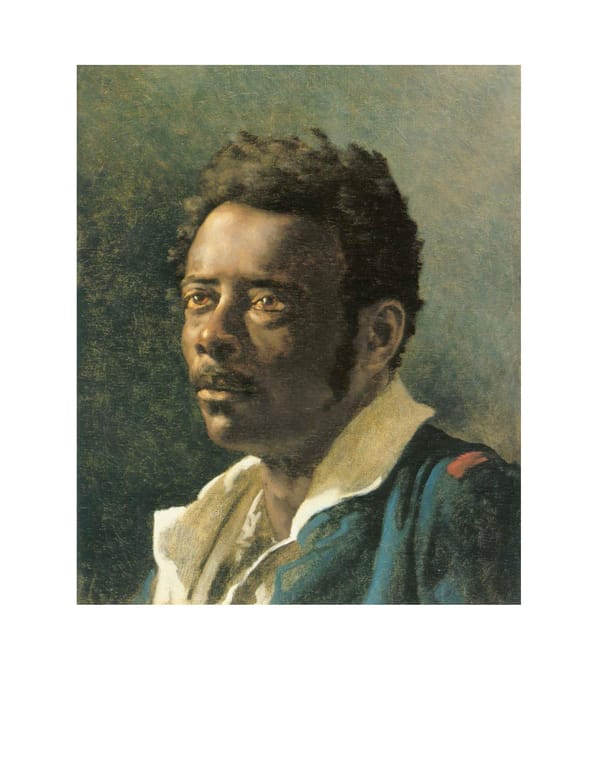
48 THEODORE GERICAULT Portraits played a relatively small part in Gericault's career, and he is best known French, 17911824 as a painter of heroic and historical subjects. The present picture, however, clearly Portrait Study, circa 181819 demonstrates that he was capable of capturing a sitter's character with great sympathy Oil on canvas and spontaneity. The portrait seems to be the study of a model, not a commissioned 46.7 x 38 cm (18 x 15 in.) work, and Gericault probably chose this subject for his extraordinary face. 85.PA.407 The artist is known to have sympathized with the cause of abolitionism and often included Africans in his pictures, sometimes in heroic roles; his admiration was influenced in part by stories of the wars the French army had fought with insurgents in Haiti during the first years of the century. He must also have known men from North Africa and shared the fascination with exotic cultures that characterized the work of many nineteenthcentury French artists. Gericault and many of his contemporaries saw the African male in a romantic light, attributing to him an unspoiled nobility that more "civilized" Europeans could not attain. It is generally thought that the sitter in the Museum's portrait was a man named Joseph—his family name is not recorded—who came from Santo Domingo in the Caribbean and worked initially in France as an acrobat and then as a model. He acquired some fame in Paris because of his considerable physical beauty, wide shoulders, and slender torso. Gericault used Joseph for a great many studies, mostly drawings, and as the principal figure in his most famous work, The Raft of the Medusa (1819; Paris, Musee du Louvre). The sitter in the Museum's painting looks a bit old to have been used for such a dramatic pose, however, and therefore may not be the same model. The many studies of Joseph that are most obviously related to the finished Raft of the Medusa do not include the mustache and slightly sad features of the Museum's portrait. Nevertheless, the latter presumably belongs to the period of 1818 to 1819 when Gericault was most preoccupied with The Raft of the Medusa. BF FRENCH SCHOOL 87
49 JACQUESLOUIS DAVID As the most prominent painter of revolutionary Paris and later the favorite painter of French, 17481825 Napoleon, David had little choice but to leave the country after the reinstatement of The Farewell of Telemachus the French monarchy in 1815. The final decade of his life, spent in voluntary exile in and Eucharis, 1818 Brussels, was marked by a transition of style and subject. His output during this time Oil on canvas consisted of intimate halflength portraits, often of fellow exiles (as in the case of the 87.2 x 103 cm (34½ x 40½ in.) Museum's other work by the artist, The Sisters Zenaide and Charlotte Bonaparte, On quiver, signed DA VID, and, on horn, dated BRUX1818 no. 50), as well as an innovative series of mythological paintings, several of which 87.PA.27 (including the present work) deal with themes of erotic entanglement. The Farewell of Telemachus and Eucharis was probably inspired by Fenelon's moralizing romance, Les Aventures de Telemaque (1699), which in turn draws its characters from Homer's Odyssey. Telemachus, the son of Ulysses and Penelope, is passionately but chastely in love with Eucharis, one of Calypso's nymphs. However, filial duty dictates that the youth must depart. David sets this intimate farewell in a secluded grotto. In spite of the antiquity of the subject, the partially clad figures are given great immediacy by the halflength format and their specificity of features; the rendering of Telemachus in particular has a portraitlike air. His dreamy adolescent expression seems already focused on his departure even while his hand continues to grip the nymph's thigh. Eucharis, by contrast, lays her cheek on Telemachus's shoulder in resignation, her arms encircling his neck in mute prorest of an inevitable leavetaking. The contrast of masculine rectitude with feminine emotion is a current that runs throughout David's oeuvre. The excellent state of preservation of this unlined canvas highlights the sophisticated color harmonies characteristic of David's late period. Telemachus was commissioned by Count Erwin von Schonborn, Vice President of the StatesGeneral of Bavaria. Later that year, he commissioned a pendant from David's most devoted student, AntoineJean Gros. Lacking the Telemachus's themes of duty and chastity, Baron Gross Bacchus and Ariadne (Phoenix Art Museum) turns up the erotic heat a notch while moving away from the carefully crafted linearity of the Neoclassical style as perfected by David. PS 88 FRENCH SCHOOL
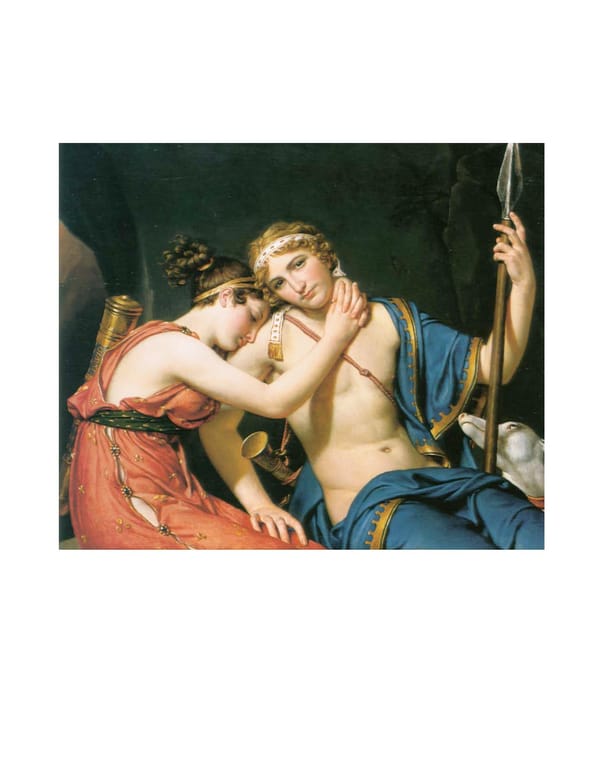
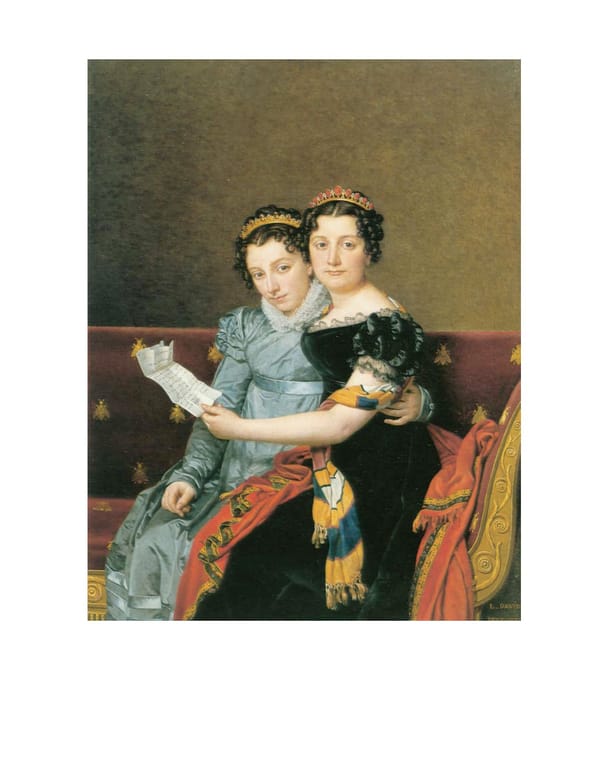
50 JACQUESLOUIS DAVID David was the artist closest to the Napoleonic government from its inception, and French, 17481825 he was commissioned to paint its most important events. His enthusiastic espousal The Sisters Zenaide and of an art based on antique models was matched by Napoleon's desire to emulate Charlotte Bonaparte, 1821 GrecoRoman civilization and principles. Both men played essential roles in the Oil on canvas development of Neoclassicism, and the style thus created dominated Europe for nearly 129.5 x 100 cm (51 x 39 in.) a halfcentury after the fall of the Napoleonic Empire. By the time the Museum's At bottom right, signed L.DAVID.IBRVX. 1821 picture was painted, however, the French monarchy had been reestablished. Although 86.PA.740 David could have returned to France, he had decided to remain in exile and was living in Brussels. The sitters of this double portrait are the daughters of Napoleon's older brother, Joseph Bonaparte (1768—1844). A key figure of the Napoleonic era, Joseph was made King of Naples and Spain at the height of France's aggressive expansion. After Napoleon's final abdication in 1815, Joseph went into exile in the United States, settling near Philadelphia in Bordentown, New Jersey. His family remained in Europe, however, and for a time resided in Brussels. On the left of the painting is nineteenyearold Charlotte, dressed in grayblue silk. She wished to become an artist and received drawing lessons from David, with whom she maintained a friendly relationship. On the right, dressed in deep blue velvet, is Zena'ide Julie, age twenty, who later became a writer and translator of Schiller, the German poet and dramatist. The sisters are depicted wearing tiaras and seated on a couch decorated with bees, the Bonaparte family emblem. As they embrace, Zenaide holds out a letter from their father on which a few words can be deciphered as well as the information that it was sent from Philadelphia. The portrait exhibits some of the trappings of imperial fashion, notably the couch in the Roman manner and the high waistlines of the gowns; yet it is not as severe and solemn as many of the artist's earlier works, and there is a sense of warmth and informality that perhaps signals a lessening of David's earlier idealistic fervor. The fabrics are rendered with great sensitivity, and the portrait, no doubt commissioned by the exiled Joseph Bonaparte, conveys a sympathetic charm that apparently survived in the face of the family's unhappy circumstances. BF FRENCH SCHOOL 91
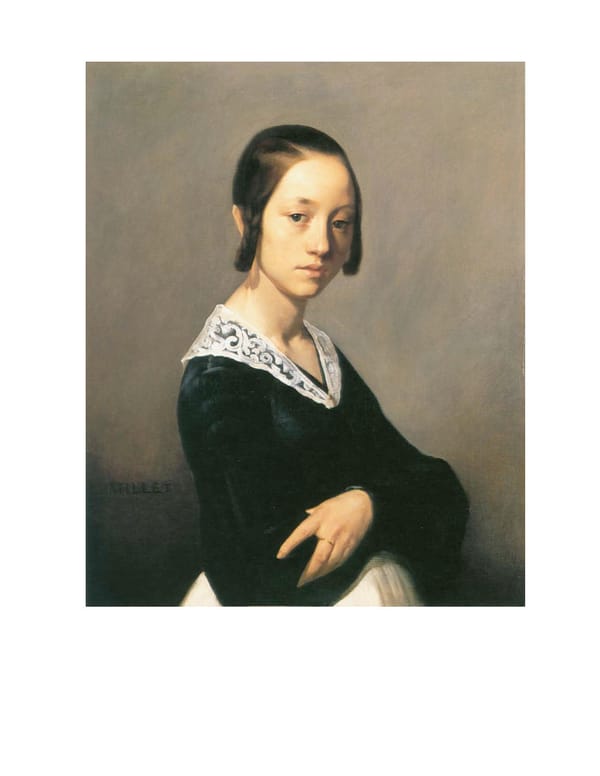
51 JEANFRANCOIS MILLET Before his international success as a painter of peasant life, JeanFrancois Millet French, 18141875 trained and earned his living as a portraitist. During the two years Millet resided in LouiseAntoinette Feuardent, the Norman city of Cherbourg (1840—42) he produced more than thirty portraits of 1841 its middleclass citizens. Among his most accomplished and moving depictions were Oil on canvas those of relatives and friends such as the young woman portrayed here. 73.3 x 60.6 cm (28 x 23 in.) LouiseAntoinette Feuardent was the wife of Millet's lifelong friend, FelixBienaime Signed at bottom left, MILLET 95.PA.67 Feuardent, a clerk in the library at Cherbourg. One of their children married the artist's daughter Marie. Millet depicts LouiseAntoinette with carefully deliberated simplicity. The plain setting, unpretentious costume, and contained stillness of mood recall images of seventeenthcentury Dutch burghers. By adapting earlier portrait conventions, Millet characterizes the understated virtue of a modern woman from the provinces. He also offers a challenging alternative to the vividly colored, hardedged society portrait developed by his older contemporary Ingres. The portrait's impact depends on the harmonious balance between monochromatic tones (termed by Millet the "ponderation of tonality") and between fluid brushwork and tightly controlled line. Millet's resolution of formal opposites is a means of expressing the sitter's selfcontainment, her alert shyness, her poised composure. LouiseAntoinette Feuardent seems an answer to Baudelaire, who said, "A portrait! What is more simple or more complicated, more obvious or more profound? This genre, so modest in appearance, demands tremendous intelligence. Without doubt, the submission of the artist to it must be great, but just as great should be his insight." DA FRENCH SCHOOL 93
52 JEANFRANCOIS MILLET The French revolutions of 1830 and 1848 gave rise to numerous liberal movements French, 18141875 intent upon correcting social ills, and a widespread belief existed among reformers Man with a Hoe, 186062 that painting should reflect these concerns rather than portray figures with classical Oil on canvas associations. Although Millet was not a social reformer, his personal convictions 80 x 99 cm (31½ x 39 in.) caused him to align himself with the reformers. At bottom right, signed J. F. MILLET 85.PA.114 A religious fatalist, Millet believed that man was condemned to bear his burdens with little hope of improvement. He wanted to show the nobility of work in his art, and to this end, he concentrated his attention on peasants and farm laborers. The Industrial Revolution had caused a steady depopulation of farms, and a painting such as Man with a Hoe was meant to show the farmer's perseverance in the face of unrelieved drudgery. In the distance a productive field is being worked, but the backbreaking task of turning the rocky, thistleridden earth must precede this. Millet's painting was criticized for the especially brutish image of the peasant. Of all the laborers depicted by Millet, this farmer is the most wretched. He has been brutalized by his work, and his image understandably frightened the Parisian bourgeoisie. Millet may have been making a reference to Christ's Passion because at the time the thistles were widely interpreted as referring to the crown of thorns. The face of the peasant, however, did not fit the thenpopular conception of Christ. Man with a Hoe, in any event, was considered a symbol of the laboring class for many decades and in 1899 was immortalized by the socialist poet Edwin Markham in a poem of the same name in which he rhetorically asked, "Whose breath blew out the light within this brain?" During and after its public exhibition in the Salon of 1863, Man with a Hoe was attacked by critics for its supposed radicalism, and Millet was forced to declare that he was not a socialist or an agitator. Although his attitude pleased neither reformers nor the establishment, his paintings proved to be very popular, particularly in the United States. Man with a Hoe, one of his most famous pictures, had been purchased by a San Francisco collector by the turn of the twentieth century. BF 94 FRENCH SCHOOL
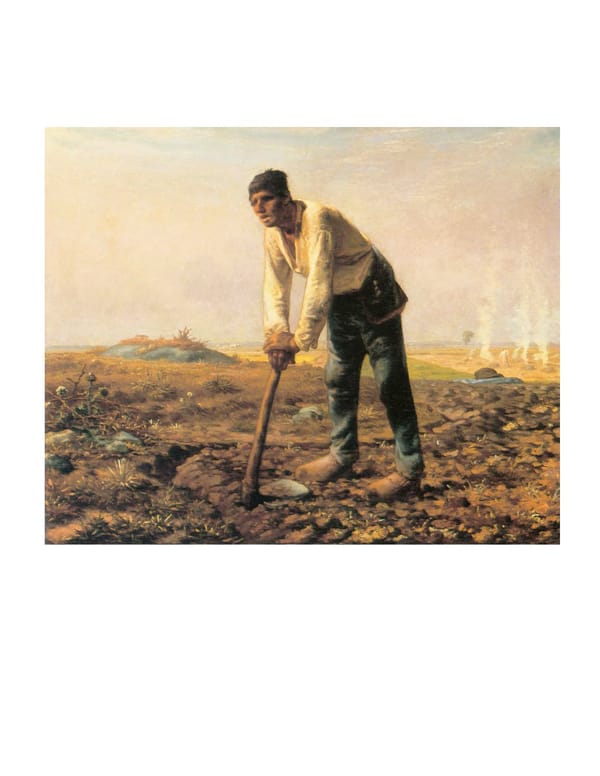
53 CLAUDE MONET The Impressionist movement was concerned above all with atmosphere and light and French, 1840-1926 their effects on the perception of color and form. Its members in general eschewed Still Life with Flowers and Fruit, the social themes often taken up by Courbet and other French artists working around 1869 the middle of the nineteenth century (see no. 52). Thus, although Monet and Courbet Oil on canvas knew and admired each other's work, they were clearly products of different generations. 100 x 80.7 cm (39 x 31¾ in.) Monet's style may have excited controversy, but his subject matter did not. At top right, signed Claude Monet 83.PA.215 The Museum's Still Life with Flowers and Fruit was created in 1869 in the town of Bougival just outside Paris. Monet spent the summer and autumn of the year in that lovely resort town, which was famous for the crowds of artists it attracted. While there, he was in regular contact with Pissarro and Renoir (see nos. 54 and 57). Monet and Renoir often painted in each other's company and created a series of pictures of the same subjects. Their famous views of La Grenouillere, a popular restaurant on the Seine with swimming facilities, were painted at this time. Renoir also depicted the arrangement of flowers and fruit seen in the Museum's painting. The two artists probably worked side by side, perhaps in Monet's studio. Renoir's painting (now in the Museum of Fine Arts, Boston) is somewhat smaller and less complex than Monet's. Carefully structured and composed, Monet's picture leaves a certain amount of empty space, which suggests the depth of the scene. The light is subdued, but the color is not, making this one of his strongest still lifes. The paint is applied in thick strokes, and the surface reflects a significant amount of reworking, an indication that the artist devoted more than the usual amount of time to its resolution. The principles of Impressionism were best demonstrated in paintings of the fields, rivers, and towns of the region immediately surrounding Paris, and members of the movement were comparatively uneasy working indoors. As a consequence, Monet and his fellow Impressionists painted relatively few still lifes. Artists such as Cezanne (see no. 60) and Gauguin would come to treat this subject matter seriously just a short time later, however, and Monet's work in this field would influence the evolution of their painting. BF 96 FRENCH SCHOOL

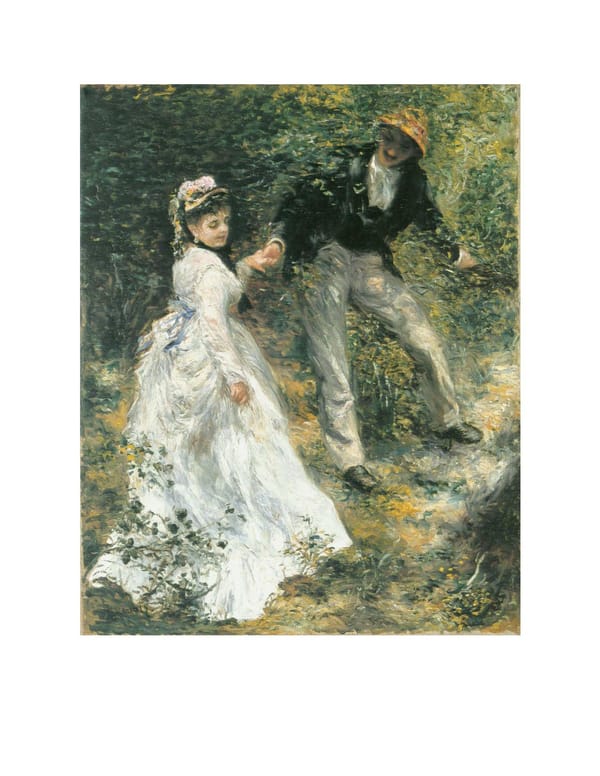
54 PIERREAUGUSTE Renoir was twentynine when he painted La Promenade and a member of a closeknit RENOIR group of young avantgarde artists soon to be fractured by France's declaration of war French, 18411919 on Germany. Having spent the previous summer painting outofdoors alongside La Promenade, 1870 Monet in La Grenouillere, Renoir displays in La Promenade a shift toward the high Oil on canvas keyed palette characteristic of the recently forged Impressionist style. In this landmark 81.3 x 65 cm (32 x 25½ in.) of early Impressionism, Renoir no longer conceives of nature as a backdrop, but rather, At lower left, signed A. Renoir. 70. 89.PA.4l by working almost certainly en plein air and by using spontaneous brushwork and Detail overleaf allover dappled light, he fully integrates the figures into their verdant setting. Themes of dalliance and leisure run throughout Renoir's oeuvre. In contrast with Monet's views of domesticity amid flowering gardens, nature for Renoir is seen both as a setting for seduction and as a metaphor for sensual pleasure. The trysting couple in the Getty canvas is at once completely modern—evocative of the new Parisian middle class, flocking on the weekends to the parks and suburbs—as well as representative of a more longstanding arthistorical motif, traceable to the amorous couples of Watteau's fetes galantes, where enticement into secluded glades is one of the stages of seduction. With his characteristic feathery brushwork, Renoir conveys in La Promenade the dappled effect of sunlight filtered through foliage that would become the hallmark of many of his greatest works of the 1870s and 1880s. Deeper in the woods and partially engulfed in shadow, the male figure appears somewhat rustic in comparison to his elegant companion, who turns back to gently pull her diaphanous white gown free of the underbrush. She has been variously identified as Rapha, the mistress of Renoir's friend Edmond Maitre, and as Lise Trehot, Renoir's own mistress. The latter possibility would suggest the shadowy figure who draws the woman forward is the artist himself, his pictorial role intended as analogous perhaps to that of the painter, drawing the viewer into the illusionistic space of the canvas. Renoir returns to this composition in 1883 for a drawing published in the magazine La Vie Moderne (December 29) in which the relative positions of the man and woman are reversed, both spatially and in terms of initiative. PS FRENCH SCHOOL 99

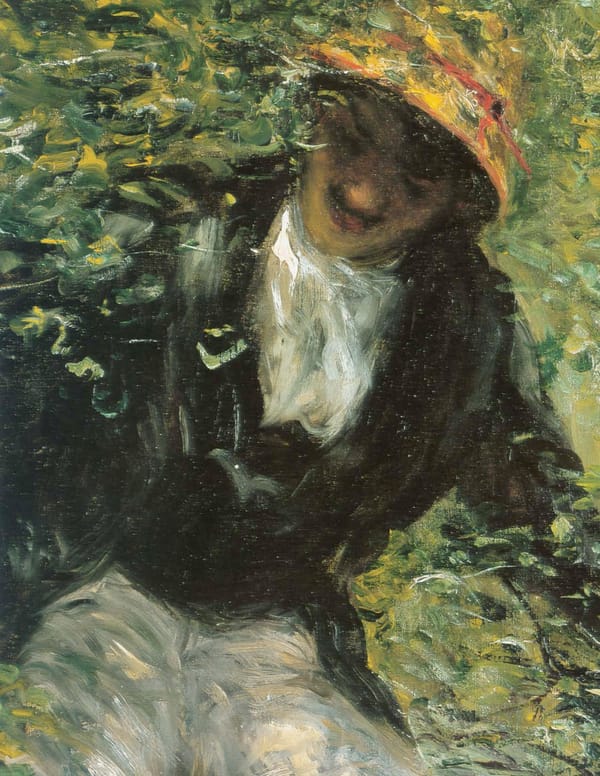
55 EDOUARD MANET Although his influence was strongly felt among the Impressionists, Manet never French, 1832-1883 officially joined their ranks. He did share with them, however, the ideal voiced by the The Rue Mosnier with Flags, poet and critic Charles Baudelaire: the commitment to depict modern Paris. The Getty 1878 canvas represents rue Mosnier (now rue de Berne) as seen from the window of Manet's Oil on canvas second-floor studio on the afternoon of June 30, 1878, a national holiday. The first 65.5 x 81 cm (25¾ x 31¾ in.) official celebration organized by the Third Republic, the Fete de la Paix was intended At lower left, signed Manet 1878 89.PA.71 both to mark the success of the recent Exposition Universelle and to commemorate France's recovery from the disastrous Franco-Prussian War of 1870-71 and the bloody Commune that followed. In the upper portion of the canvas, hansom cabs pull to the side of the street to load and unload their elegant passengers. The artist uses the cool tonalities of the recently constructed, prosperous-looking street as a pale backdrop for the sparkling daubs of red, white, and blue paint; the staccato repetition of the French tricolore on a bright, gusty day summons up a sense of patriotic fervor that is reinforced by Manet's energetic and fluid brushwork. Counterbalancing this distant, glittering bustle, the emptiness of the street in the foreground is punctuated only by two solitary figures, neither one participating in the celebration. A worker carrying a ladder is radically cropped by the lower edge of the composition. Further on, an amputee, perhaps a war veteran, wears the blue blouse and casquette of a Parisian laborer; his back to the viewer, this hunched figure makes slow progress on his crutches. A shabby fence to the left attempts to conceal a yard of rubble created by nearby railroad construction. Considered as a whole, The Rue Mosnier presents a view of national pride and newfound prosperity tempered by a sensitivity to the associated costs and sacrifices. Perhaps earlier the same day, Manet depicted the same view in a sketchier, less highly finished version (Zurich, Buhrle collection). Claude Monet also painted two street scenes on June 30, one of rue Montorgueuil (Paris, Musee d'Orsay) and one of rue Saint-Denis (Rouen, Musee des Beaux-Arts). In contrast to Manet's somewhat ironic observations on the government-organized festivities, Monet's colorful use of all-over broken brushwork suggests an urban patriotic spectacle at once euphoric and impersonal. PS 102 FRENCH SCHOOL
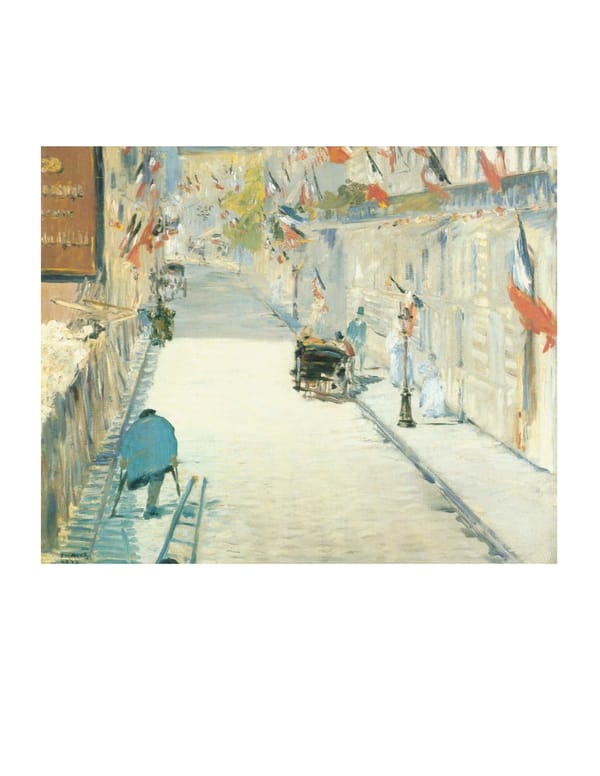
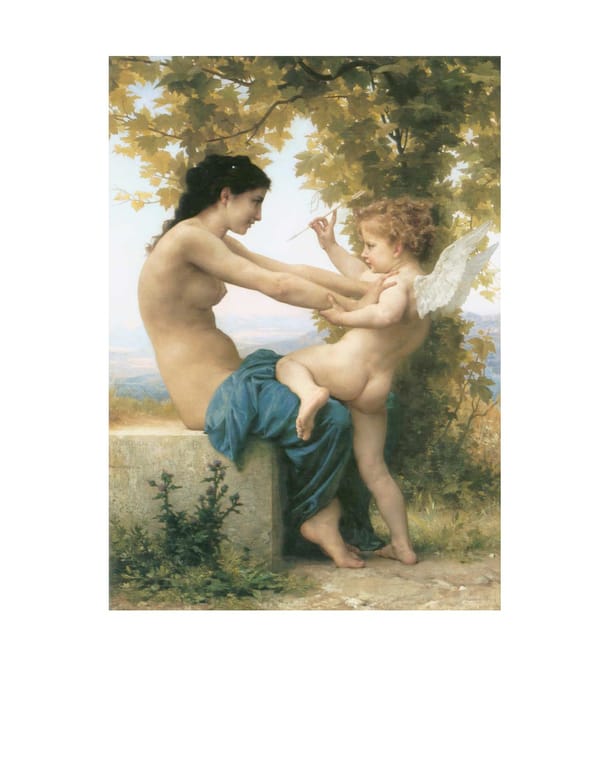
56 WILLIAM ADOLPHE As a member of the French Academy and a proponent of highly finished and BOUGUEREAU sensuous classicism, Bouguereau was considered the heir to the grand tradition of French, 1825-1905 European master painting. He was one of the most honored painters of the period. Young Girl Defending Herself His idyllic mythologies, such as Young Girl Defending Herself Against Eros, appealed Against Eros, circa 1880 tremendously to the crowds who visited the annual exhibitions at the Paris Salon. For Oil on canvas them such glimpses into a convincingly conjured Arcadia provided escape from the 79.5 x 55 cm (31¾ x 21 in.) Signed left center on block, complexities and regimented chaos of modern urban life. W.BOVGVEREAV Bouguereau exhibited a large version of Young Girl Defending Herself Against 70.PA.3 Eros (University of North Carolina at Wilmington) at the Salon of 1880. Heralded as one of the artist's best "mythologies," its success led Bouguereau to produce the Getty Museum's smaller autograph replica for the private market. The painting's sparkling immediacy results from Bouguereau's free reinvention of the classical past. Because the subject is without an ancient literary source, it invites the viewer to imaginatively supply the narrative. Will the girl's resistance triumph, or will Love's arrow find its mark? The painting captures the theatrical accoutrements of Bouguereau's studio, casting the dark, sylvan beauty of his favorite model as the smiling girl and equipping the primal god of love with the stage-prop wings of a dove. The setting and vegetation are recognizably French. Even the soft white light may recall the winter sky as it was reflected through the windows of the artist's studio where, in a note to his daughter, he wrote that he began the composition on December 1, 1879. At the turn of the twentieth century Bouguereau's work was as highly prized by Americans as it was by his compatriots. One of J. Paul Getty's early acquisitions, Young Girl Defending Herself Against Eros remained in his collection in Surrey, England, from 1941 until its donation to the Museum in 1970. DA FRENCH SCHOOL 105
57 PIERREAUGUSTE RENOIR French, 18411919 Albert Cahen d'Anvers, 1881 Oil on canvas 79.8 x 63.7 cm (31 7/16 x 25 in.) At lower right, signed Renoir/Wargemont. 9. Sbre 81. 88.PA.133 Twenty years into his career, Renoir became so disenchanted with Impressionism that he called the movement a "blind alley." He transformed his style, harmonizing the loose, painterly effects of his early works such as La Promenade (no. 54) with the firm contours and weighty forms reminiscent of Renaissance painting. Through these means Renoir won the favor of the wealthy Parisian patrons who commissioned portraits from him. These works were well received at the official Salons, and by 1880 Renoir vowed to exhibit only portraits there. One of the freshest examples of the artist's new approach is this portrait of the orchestral composer Albert Cahen d'Anvers (18461903). Albert, the younger brother of the financier Louis Cahen d'Anvers, is shown nonchalantly smoking a cigarette in the salon at Wargemont, the home of Renoir's great patron Paul Berard. In the portrait Renoir reproduces the room's exuberant decor and contrasts its bright blue patterns with the young man's own vivid coloring. The juxtaposition of similar forms maintains the unity between sitter and setting. Albert's curled mustache, for example, complements the curves of the floral wallpaper; his ruffled hair echoes the feathered red leaves of the potted plant. This subtly contrived composition creates a mood of relaxed elegance that is, however, given an edge by the artist's focus on Cahen d'Anvers's distant, yet sparklingly alert, gaze. The composer's ultimate detachment from the viewer, in combination with the attribute of a cigarette, hints, perhaps, at his creative vocation. DA 106 FRENCH SCHOOL
58 EDGAR DEGAS French, 18341917 Waiting, circa 1882 Pastel on paper 48.2 x 61 cm (19 x 24 in.) At top left, signed Degas 83.GG.219 Owned jointly with the Norton Simon Art Foundation, Pasadena Degas, like many French artists at the middle of the nineteenth century, concentrated on representing the various facets of Parisian daily life. He treated both mundane and fashionable subjects, ranging from women washing and ironing to the occupations of musicians and jockeys. Degas's single most common theme, however, was the ballet. He is credited with once remarking that the dance was only "a pretext for painting prerty costumes and representing movements," but his work belies this observation. The American collector Louisine Havemeyer—who formerly owned the Museum's picture—is supposed to have inquired of the artist why he painted so many dancers; he replied that ballet was "all that is left us of the combined movements of the Greeks." Somewhat paradoxically, however, he most often showed his dancers at practice or in repose and seldom painted actual performances. The Museum's pastel, which is thought to have been executed about 1882, includes a dancer and an older woman dressed in black, holding an umbrella. Tradition has it that the subject was a young dancer from the provinces who was waiting with her mother for an audition. Degas sometimes included instructors or musicians in his works to act as foils to the more colorful dancers; placing the rather severe figure of the older woman next to a young dancer rubbing her sore ankle is a variation of this practice. It also emphasizes the discrepancy between the glamour and artifice of the stage and the drabness of everyday life. BF FRENCH SCHOOL 107
59 CLAUDE MONET In the fall of 1890 Monet, the acknowledged master of Impressionist landscape, began French, 1840-1926 his first series. His motif was the wheatstacks located in a field just outside his garden Wheatstacks, Snow Effect, at Giverny. Using brightly colored, rhythmically applied pigments, Monet produced Morning, 1891 thirty canvases that captured what he called his "experience" of the wheatstacks as they Oil on canvas were transformed by nature's permutations. He said, "For me a landscape hardly exists 65 x 100 cm (25½ x 39¼ in.) at all as a landscape, because its appearance is constantly changing; but it lives by virtue At lower left, signed and dated Claude Monet '91 of its surroundings—the air and the light—which vary continually." 95.PA.63 In May 1891 Monet's exhibition of fifteen of the wheatstack paintings at the Galerie Durand-Ruel, Paris, caused a sensation. It seemed to Monet's friend the critic Gustave Geffroy as if the artist had unmasked the "changing faces of nature" and captured its very mood. To Geffroy the winter wheatstacks, frozen in snow, evoked "the white silence of space." But it was a stillness broken by the impact of the artist's hand as it recorded, "snow... lit with a rosy light shot through with pure blue shadows" and "nature's mysterious enchantment [murmuring] incantations of form and color." Monet completed Wheatstacks, Snow Effect, Morning in February 1891 and sold it four months before the famous exhibition. It is one of the most tightly structured paintings in the series. The rounded forms of the stacks are played off against the firm, horizontal geometries of the receding field, hills, and sky. Form and color take on the same visual substance as the solid red stacks are brought into compositional balance by the intense blue of their cast shadows. Varied brushstrokes evoke different light effects, such as the delicate pastel nuances in the muted winter sky, or the bright flecked reflections on the stacks. The painting's densely worked, complex surface records Monet's long, intense efforts in the studio as he strove to capture a particular moment that he said would never return. DA 108 FRENCH SCHOOL

60 PAUL CEZANNE The still life held an obsession for Cezanne throughout his career. From the 1880s French, 1839-1906 until the end of his life, he repeatedly painted the same objects—a green vase, rum Still Life with Apples, 1893-94 bottle, blue ginger pot, and apples. The immobility and longevity of the subjects Oil on canvas allowed him the time and control to pursue his searching analyses of the relationship 65.5 x 81.5 cm (25¾ x 32 in.) between space and object, between visual experience and pictorial rendering. 96.PA.8 A work from his mature and most influential period, Still Life with Apples is a powerfully rendered image of familiar objects. The graceful rhythms created by the swinging black arabesques of the blue cloth, the looping rattan, the swelling curves of the pots and fruit, and the billowing folds of the white cloth are played against the strong horizontals and verticals of the composition. Cezanne self-consciously integrates these objects to lock the composition together: a black arabesque seemingly escapes from the blue cloth to capture an apple in the center; the sinuous curves of the blue ginger pot's rattan straps rhythmically merge with their counterparts on the bottle. The artist carefully balances colors and textures: against the shimmering blues of the background and cloth, a rough green vase stands in perfect counterpoint to the light-flecked red and yellow apples. Cezanne gives form and mass to objects through the constructive juxtaposition of colored brushstrokes. He has applied each stroke almost lovingly, caressing apples, pots, and cloth with equal concentration of purpose. In 1907 the German poet Rainer Maria Rilke, struck by the seductive quality of this painting's color and brushwork, compared the hues of the red apples pressing against the blue cloth to "the contact between two Rodin nudes." Cezanne's orchestration of composition, color, and brushwork results in an image of eloquently sustained balance. The artist's professed ambition "to do Poussin again after nature" and to make of Impressionism "something solid and enduring" are achieved in this classic and timeless work. JH 110 FRENCH SCHOOL

61 JEANETIENNE LIOTARD Swiss, 17021789 Maria Frederike van ReedeAthlone at Seven Years of Age, 175556 Pastel on vellum 57.2 x 43 cm (22½ x 18½ in.) At top right, signed peintpar/J E Liotard/1755 & 1756 83.PC.273 Portraiture reached its most refined and cultivated state during the eighteenth century. The number of artists whose chief occupation was the painting of likenesses increased, and their subjects began to include members of the burgeoning middle class as well as royal and aristocratic patrons. Born in Geneva, Liotard was trained in Paris, spent time in Rome, traveled with English friends to Constantinople, and then worked for varying lengths of time in Vienna, London, Holland, Paris, and Lyons, generally returning home to Switzerland in between his stays abroad. As his popularity spread, his sitters often came to him, but he remained one of the besttraveled figures of his time. Liotard was a very idiosyncratic artist whose personal habits and dress were unorthodox; he sometimes sported a long beard and wore Turkish costume. His highly individual lifestyle was reflected in his work and sets it apart from that of his contemporaries. In his writings, Liotard insisted that painting should adhere strictly to what could be seen with the eyes and employ the least possible embellishment. Most of his portraits depict royal sitters or members of the aristocracy rendered sympathetically and without pomp or elaborate trappings. The backgrounds are simple or nonexistent, and the sitters often look away as if they were not posing. The portrait of Maria Frederike van ReedeAthlone was painted in pastels, Liotard's favored medium, between 1755 and 1756, when the artist was working in the Netherlands. Initially, he painted a portrait of the young girl's mother, the Baroness van Reede, who then commissioned one of her daughter. Maria Frederike, just seven years old at the time, is shown dressed in a cape of blue velvet trimmed with ermine; she holds a black lap dog, who stares at the viewer. The girl's pretty features and fresh complexion make this one of the most endearing of the artist's portraits. One also sees here the range and spontaneity that Liotard was able to bring to the use of pastels. BF 112 OTHER SCHOOLS
62 THOMAS GAINSBOROUGH English, 17271788 James Christie, 1778 Oil on canvas 126 x 102 cm (49 x 40 in.) 70.PA.16 In the eighteenth century, as today, London was the center of the international art trade. The English at that time were, and remained for the next century, the most avid collectors of pictures from all the major schools—Italy, France, Holland, Flanders, and Spain. Public museums did not yet exist, and except for a few private collections to which one might gain entry upon request, auction houses were one of the few places where a large number of artworks were regularly available for viewing. The auctioneer's role in the London art world was therefore considerable. James Christie (1730—1803) was the founder of the London auction house that still bears his name. He began his career as an auctioneer in 1762 and within a very few years had made his firm into the most important and successful in Europe. Christie's auction rooms were next door to the studio of his friend Thomas Gainsborough, who at that time was one of the most famous portrait and landscape painters in England. Christie may have asked Gainsborough to paint his portrait in 1778, the year it was exhibited at the Royal Academy. Until the twentieth century, the portrait hung in the auctioneer's salesrooms. An impressive figure, tall and dignified, the auctioneer is shown leaning on a landscape painting that is clearly in the style of Gainsborough, and he holds a paper in his right hand, perhaps a list of items to be auctioned. The very fluid brushwork and the ease and grace of the pose that invariably flatter the subject are characteristic of Gainsborough's portraits. BF OTHER SCHOOLS 113
63 FRANCISCO JOSE DE The widespread censorship and oppression instituted by Ferdinand VII following his GOYA Y LUCIENTES restoration to the Spanish throne in 1823 caused many liberals to abandon Spain in Spanish, 1746-1828 voluntary exile. Francisco de Goya, the greatest Spanish painter of the period, left the Bullfight, Suerte de Varas, 1824 country for France at age seventy-eight. An inscription on the back of the original Oil on canvas canvas identifies the present work, which Goya painted in Paris that summer, as a gift 52 x 62 cm(19¾ x 23 in.) for his friend and compatriot in exile Joaquin Maria Ferrer. 93.PA.1 The bullfight as an artistic subject was popularized by Goya and recurs throughout his career. A lifelong aficionado, he regularly attended bullfights and occasionally dressed as a matador himself. Goya's first serial treatment of the subject, a group of cabinet paintings dated from 1793 to 1794, employed a pastel Rococo palette to describe the intricately costumed bullfighters and the elegant stands of spectators. By 1816, when Goya published the thirty-three etched plates depicting bullfights called the Tauromaquia, much had changed. Reinstated after a temporary ban, the sport of bullfighting was generally considered to be in a state of decline. Goya apparently shared the public's objection to the new abusive tactics; the plates of the Tauromaquia isolate the central figures of the drama and stress the integral aspects of cruelty and death. The Getty Bullfight has great importance as Goya's final painted essay on this theme. Like the graphic work that largely occupied his time in his final years, Suerte de Varas exhibits a technical freedom and expressiveness typical of the artist's late style. For the most part, Goya's work in France took up themes from earlier in his career, which he reinvigorated by pushing the limits of experimental technique. The composition of the Bullfight is loosely based on number 27 of the Tauromaquia series, which shows the celebrared picador Fernando del Toro on a blindfolded horse, drawing his pique on the halted bull. In the painted version, the horse has no blindfold and the faces of the bullfighters have been transformed into an anonymous tableau of fear and grim determination. The crowded stands in the background are indicated in an abbreviated gray wash. For the foreground drama, a spare palette of black, white, bright red, ocher, and turquoise, often in a roughly worked impasto, reinforces the contrast between the glittering costumes of the picadors and the vivid wounds of the gored and dying animals. PS 114 OTHER SCHOOLS
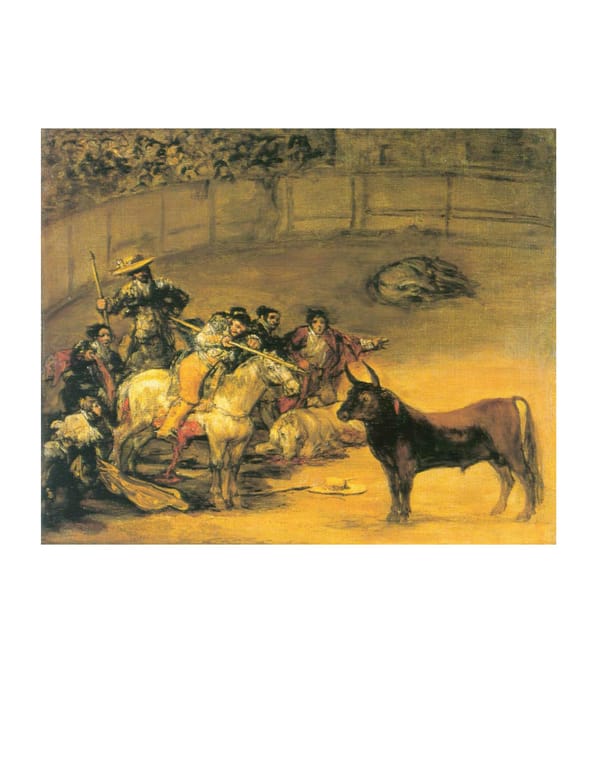
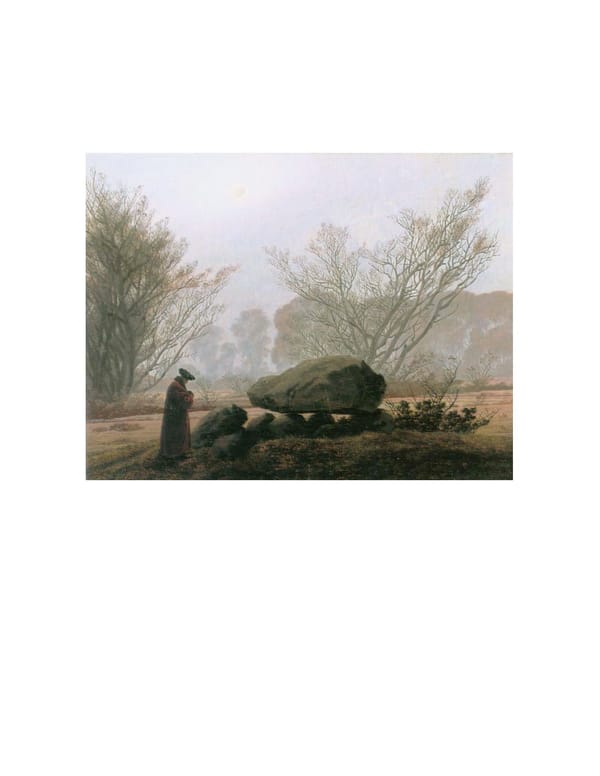
64 CASPAR DAVID A central figure in the German Romantic movement, Friedrich's deeply personal and FRIEDRICH introspective vision addressed Christian themes through analogies based on the cycles German, 17741840 of nature. Although his work initially attracted a wide following, changes in fashion A Walk at Dusk, circa 183235 and patronage left him in poverty during his final years. Among the small group of Oil on canvas works Friedrich completed before a debilitating stroke in 1835, A Walk at Dusk 33.3 x 43.7 cm (13 x 17 3/16 in.) embodies both the melancholy of this period as well as the consolation he found in 93.PA.14 the Christian faith. Unlike his contemporaries, Friedrich eschewed travel to Italy, finding his inspiration instead in the wide open spaces of his native Pomerania in northern Germany. In the present work, a solitary figure—perhaps the artist himself—contemplates a megalithic tomb with its implicit message of death as man's final end, a sentiment echoed by the barren forms of the two leafless trees that loom like specters behind the man and the grave. As a counterbalance, a second reading of hope and redemption is conveyed by the verdant grove in the distance and the waxing sickle moon, for Friedrich a symbol of divine light and Christ's promise of rebirth. The configuration of rocks used in A Walk at Dusk corresponds closely to a drawing of an actual tomb Friedrich made in 1802 near Gutzkow south of Greifswald, Friedrich's birthplace (now in the Wallraf Richartz Museum, Cologne). He seems to have used the same study for an earlier painting, Megalithic Tomb in the Snow (Dresden, Gemaldegalerie), which shows the tomb from a greater distance, dusted with snow and surrounded by a stand of onceimpressive colossal oaks that are now dead and broken. In the Getty canvas, a figure has been added to the landscape, not as a subject in the traditional sense, but more as a visual corollary to the contemplative state the artist sought to evoke in the viewer. The motif of the megalithic tomb recurs throughout Friedrich's oeuvre. Yet, like all his major motifs, they become part of the artist's personal iconography and are recombined freely according to his inner vision. PS OTHER SCHOOLS 117
65 JOSEPH MALLORD A reverence for great artists of the past coexists in unlikely harmony throughout WILLIAM TURNER Turner's oeuvre with his celebrated technical experimentation. This painting, along English, 17751851 with the other seapieces exhibited by Turner in 1844, his seventieth year, constituted Van Tromp, going about to the artist's final homage to the Dutch tradition. The seapiece held great meaning for please his Masters, Ships a Sea, getting a Good Wetting, 1844 Turner and his contemporaries both as an expression of the sublime in nature and as the symbolic arena of British ascendancy in trade and empire. Oil on canvas 91.4 x 121.9 cm (36x48 in.) The Getty Van Tromp is the last in a series of four canvases depicting what seems to 93.PA.32 be an amalgam of two men, Admiral Maarten Harpertszoon Tromp (15981653) and his son Cornelis (16291691)—the "van" being an erroneous addition that gained currency in eighteenthcentury England. Both men earned renown for their naval victories against British and Spanish fleets during a period when Dutch seafaring power was on the rise. However, the precise historical episode depicted in Van Tromp has eluded definitive identification in spite of the lengthy title provided by the artist himself for the Royal Academy exhibition catalogue in 1844. In the first of two possible subjects proposed by scholars, the Van Tromp represented would be the son, Cornelis, who, preferring to follow his own strategy, was dismissed from service in 1666 after failing to follow orders. He was reinstated in service and reconciled with his superiors in 1673. Perhaps as a symbolic overture signaling his submission to authority, Tromp is shown "going about to please his Masters." He skillfully executes the maneuver while posed defiantly on the foredeck of his ship, braced against the heavy spray of breaking waves, luminous in his (ahistorical) white uniform. The second suggestion has the protagonist as the father, Maarten Tromp, who, during the AngloDutch war in 1652, led three hundred Dutch merchant ships through the English Channel and safely back to Dutch waters. Tromp was said to have tied a broom to his mast (visible in the painting) to symbolize sweeping the British from the seas. With the representation of such historical narratives (their accuracy aside), Turner elevates the seascape to the pinnacle of prestige previously reserved for history painting. In the Getty Van Tromp, Turner expresses the sublime power of nature as seen by a Romantic painter through the lens of the Dutch seascape. PS 118 OTHER SCHOOLS
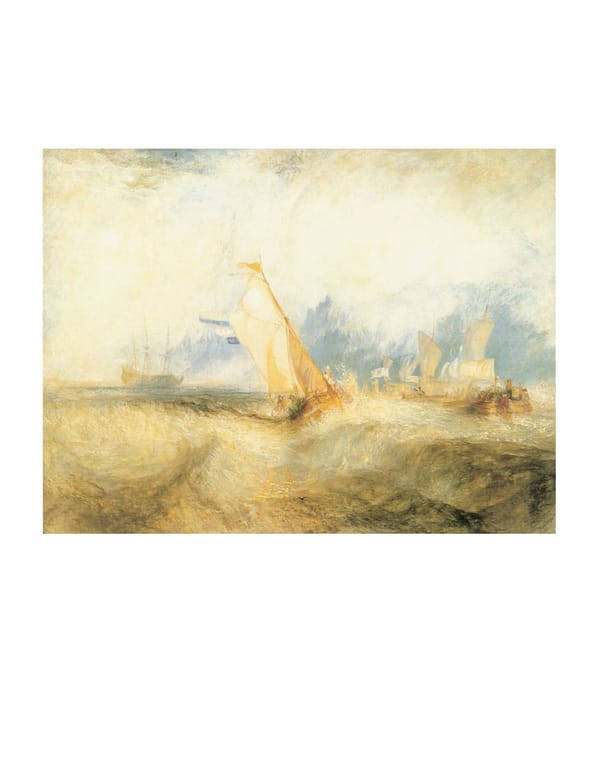
66 JAMES ENSOR Caricature and societal critique are elevated to a high art form in this painting, James Belgian, 18601949 Ensor's monumental manifesto on the state of Belgian society and modern art in the Christ's Entry into Brussels in later nineteenth century. Painted in 1888, Christ's Entry into Brussels in 1889 sets the 1889, 1888 second coming of Christ in the Belgian capital one year hence. Aggressively insular Oil on canvas in his artistic outlook, Ensor painted Christ's Entry partly in response to the critical 252.5 x 430.5 cm (99½ x I69½ in.) success that had met French painter Georges Seurat's Sunday Afternoon on the Island At right center, signed J. ENSOR/1888 87.PA.96 of the Grande Jatte when it was exhibited in Brussels the year before. Ensor was Detail overleaf angered as much by the cool, controlled Pointillist style pioneered by Seurat as by his interpretation of the Frenchman's conception of a placid, classless society blandly enjoying leisuretime diversions on the banks of the Seine. By contrast, Ensor portrays contemporary society as a cacophonous, leering mob. In nightmarish fashion, elements of preLent carnival and political demonstrations merge with Christ's procession. Threatening to trample the viewer, the crowd pours into the foreground, which is arranged in a steep, wideangle perspective. In the front, leading the festivities, is Emile Littre, the atheist socialist reformer, clothed by Ensor in bishop's garb. The mayor stands on a stage to the right, dwarfed by his podium and surrounded by clowns. Jostled and overwhelmed, Christ numbly rides his donkey in the middle ground, more an object of curiosity than of reverence. In the northern tradition of Bosch and Brueghel, an onlooker in the upper left leans over a balcony to vomit onto a banner marked with the insignia of Les XX (Les Vingt), the Belgian avantgarde artists' association, which would ultimately reject this painting from its annual salon despite Ensor's status as a founding member. By giving Jesus his own features, Ensor projects his own sufferings and aspirations onto the Passion of Christ. Here, and throughout his oeuvre, Ensor finds means to express his horror at human depravity and vice in the imagery of skeletons and the carnival masks that he drew from observing those that would annually fill his mother's souvenir shop in the seaside resort town of Ostend. Joining the masks and skeletons in an uncanny procession, public, historical, and allegorical figures commingle with members of the artist's immediate circle of family and friends. With its aggressive, painterly style and complex merging of the public with the deeply personal, Christ's Entry has long been regarded as a harbinger of twentiethcentury Expressionism. PS 120 OTHER SCHOOLS
Image Not Available for Publication
Image Not Available for Publication
Image Not Available for Publication

67 LAWRENCE ALMA Sir Lawrence Alma Tadema was one of the most popular and successful painters of his TADEMA time. Although his reputation has suffered as a result of the change in taste that favored Dutch/English, 18361912 Courbet and, later, the Impressionists (see nos. 5355 and 57—60), his work still holds Spring, 1894 a fascination for us because of its extraordinarily meticulous technique. Oil on canvas The artist's style had its origins in seventeenthcentury Dutch painting of everyday 178.4 x 80 cm (70½ x 3I½ in.) scenes, but the bulk of his work was dedicated to Greek or Roman subjects. Rather At bottom left, signed L. ALMA TADEMA OP CCCXXVI than the heroic or literary, however, the themes of his paintings are usually simple 72.PA.3 ones—to the modern eye even banal at times—chosen to represent daily existence in preChristian times. They also reflect Victorian sensibilities regarding social behavior. In the midst of the enormous economic upheaval and social discord the Industrial Revolution had brought to England, a segment of the upper class, to which Alma Tadema belonged, continued to look back to the classical past as a simpler, idealized time. His was probably the last generation to do so with such unequivocal admiration. The Museum's painting is one of Alma Tadema's largest. He is known to have spent four years working on it, finishing in 1894, in time for the winter 1895 exhibition at the Royal Academy. Depicted is the Roman festival of Cerealia, which was dedicated to Ceres, the corn goddess. Although the edifice represented is essentially a product of the artist's imagination, he has incorporated portions of extant Roman buildings, and the inscriptions and reliefs can be traced to antique sources, reflecting the artist's profound interest in classical civilization and architectural detail. The painting still bears its original frame, inscribed with a poem by Alma Tadema's friend Algernon Charles Swinburne; it reveals a particularly idyllic view of Rome: "In a land of clear colours and stories/In a region of shadowless hours/Where the earth has a garment of glories/ And a murmur of musical flowers." Spring was an enormous popular success, and its fame spread to a wide audience via many commercial prints and reproductions. BF OTHER SCHOOLS 125
68 EDVARD MUNCH Edvard Munch stands between the Romantic painters of the early nineteenth century Norwegian, 18631944 and the early twentiethcentury Expressionists. His work evokes the brooding quality Starry Night, 1893 and psychological isolation of the Romantic spirit combined with a stark, almost Oil on canvas primitive directness of execution, which anticipates the comparatively uninhibited 135 x 140 cm (53 x 55 in.) individualism of our own century. At bottom left, signed EMunch 84.PA.681 Starry Night, a depiction of a coastal scene, is one of the few pure landscapes the artist painted in the 1890s. It was executed in 1893 at Asgardstrand, a small beach resort south of Oslo. Munch spent his summers there and often included one or more of the towns prominent landmarks in his pictures. In spite of the fact that this was a place of relaxation and pleasure, Munch's paintings of it often suggest personal anxieties and sometimes even terror. Because the Museum's painting does not include figures or the town's pier—which would have been just off to the left—it has a more abstract quality than usual and an ambiguous sense of scale. It is an attempt to capture the emotions called forth by the night rather than to record its picturesque qualities. The mound at the right represents three trees. The vaguely defined shape on the fence in the foreground is thought to be a shadow, probably that of two lovers who are placed in the same setting in a lithograph of 1896. The white line before the clump of trees, which parallels the reflections of the stars on the sea, may be a flagpole, but it seems more like some natural phenomenon, such as a flash of light. Munch's Starry Night was included in a series of exhibitions held between 1894 and 1902, each time with a different title. It was referred to as Mysticism or Mysticism of a Starry Night on occasion and was part of a group called Studies for a MoodSeries: "Love." Later it seems to have been included in the artist's 1902 Berlin exhibition as part of the same series, now called Frieze of Life. This group of paintings was a very personal, philosophical commentary on man and his fate and was imbued with religious overtones. BF 126 OTHER SCHOOLS
Image Not Available for Publication
INDEX OF ARTISTS Numerals refer to page numbers Alma Tadema, Lawrence 125 Gainsborough, Thomas 113 Pontormo 31 Gericault, Theodore 84, 85, 87 Potter, Paulus 65 Bartolommeo, Fra 23 Gogh, Vincent van 73 Poussin, Nicolas 79 Bellotto, Bernardo 38 Goya y Lucientes, Francisco Jose de 114 Bosschaert, Ambrosius, the Elder 49 Greuze, JeanBaptiste 81 Rembrandt Harmensz. van Rijn Bouguereau, William Adolphe 105 57, 59, 60 Bouts, Dieric 42 Huysum, Jan van 70 Renoir, PierreAuguste 99, 106 Brueghel, Jan, the Elder 46 Roberti, Ercole de' 16 Koninck, Philips 69 Romano, Giulio 24 Cappelle, Jan van de 63 Rubens, Peter Paul 50 Carpaccio, Vittore 18 La Tour, Georges de 75 Ruisdael, Jacob van 64 Cezanne, Paul 110 La Tour, MauriceQuentin de 83 Correggio 25 Liotard, JeanEtienne 112 Saenredam, Pieter Jansz. 55 Lusieri, Giovanni Battista 39 Steen, Jan 66 Daddi, Bernardo 10 David, JacquesLouis 88, 91 Manet, Edouard 102 Titian 32 Degas, Edgar 107 Mantegna, Andrea 20 Troy, JeanFrancois de 80 Domenichino 36 Martini, Simone 8 Turner, Joseph Mallord William 118 Dossi, Dosso 27, 28 Masaccio 15 Dyck, Anthony van 52, 54 Millet, JeanFrancois 93, 94 Veronese 35 Mola, Pier Francesco 37 Vouet, Simon 76 Ensor, James 120 Monet, Claude 96, 108 Munch, Edvard 126 Weyden, Rogier van der, Workshop of Fabriano, Gentile da 13 45 Friedrich, Caspar David 117 Piombo, Sebastiano del 30 Wtewael, Joachim 48 128 INDEX
